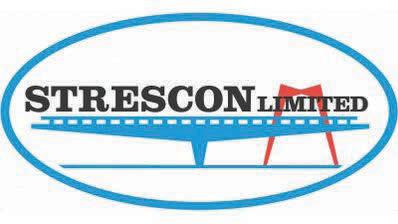
Remembering the Walkerton Water Crisis 25 years later
Toronto’s Deep Lake Water Cooling System celebrates expansion and 20-year anniversary
Return activated sludge pumps play pivotal role in wastewater treatment




Remembering the Walkerton Water Crisis 25 years later
Toronto’s Deep Lake Water Cooling System celebrates expansion and 20-year anniversary
Return activated sludge pumps play pivotal role in wastewater treatment



Engineered for Horizontal Directional Drilling (HDD) and other trenchless applications, TerraBrute® CR is a 100% non-metallic, AWWA C900 PVC pressure pipe system. Non-corroding and installation-friendly, TerraBrute® CR lets you standardize on PVC throughout your municipal water infrastructure. Designed for large diameter projects up to 24 inches, it offers unmatched strength and leak-free performance in high-pressure environments, ensuring efficient, cost-effective solutions with minimal disruption.





REDUCED INSTALLATION COSTS
Install low pressure sewer pipes first and delay grinder pump costs until the home is sold
INCREASE SYSTEM FLEXIBILITY
Pressure Sewer Systems can handle long distances and any terrain, overcoming challenges that gravity systems can’t
Closed system eliminates risk of system leaking and contaminating groundwater, streams, lakes, and oceans
cranepumps.com/market/pressure-sewer/

Editor and Publisher STEVE DAVEY steve@esemag.com
Managing Editor PETER DAVEY peter@esemag.com
Contributing Editor DAVID NESSETH david@esemag.com
Sales Director PENNY DAVEY penny@esemag.com
Sales Representative DENISE SIMPSON denise@esemag.com
Accounting SANDRA DAVEY sandra@esemag.com
Design & Production MIGUEL AGAWIN miguel@esemag.com
Circulation BRIAN GILLETT ese@mysubscription.ca
Archis Ambulkar, Toledo Technology Academy of Engineering
Gary Burrows, City of London
Patrick Coleman, Stantec
Bill De Angelis, Metrolinx
Mohammed Elenany, Urban Systems
William Fernandes, City of Toronto
Marie Meunier, John Meunier Inc., Québec
Tony Petrucci, Black & Veatch
Environmental Science & Engineering is a bi‑monthly business publication of Environmental Science & Engineering Publications Inc. An all Canadian publication, ES&E provides authoritative editorial coverage of Canada’s municipal and industrial environmental control systems and drinking water treatment and distribution.
Readers include consulting engineers, industrial plant managers and engineers, key municipal, provincial and federal environmental officials, water and wastewater plant operators and contractors.
Information contained in ES&E has been compiled from sources believed to be correct. ES&E cannot be responsible for the accuracy of articles or other editorial matter. Articles in this magazine are intended to provide information rather than give legal or other professional advice.
Canadian Publications Mail Sales Second Class Mail
Product Agreement No. 40065446 Registration No. 7750
Subscription Changes?
Please email reader subscription changes to ese@mysubscription.ca, or call 705-502-0024
Advertising Penny Davey Sales Director 416 807 3812 penny@esemag.com
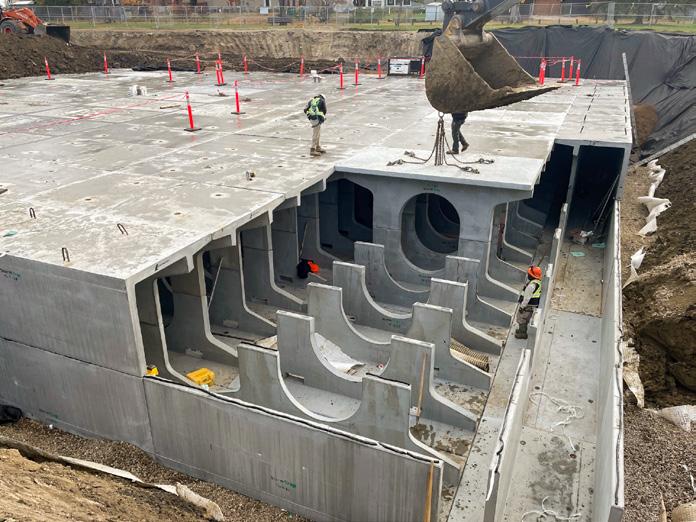

6 OWWA honours William Fernandes for his mentorship efforts
8 Resilience and reform: Remembering the Walkerton Water Crisis 25 years later
10 Examining the causes of litigious flooding events
14 Retrofitting Acton’s WWTP creates sustainable office space
16 Toronto’s Deep Lake Water Cooling System celebrates an expansion and a 20-year anniversary
19 Preventing VOC leaks in sustainable industrial operations
20 Enhancing groundwater recharge through wetland conservation and restoration
22 Causes and solutions for vapour lock in chemical metering pumps
24 The importance of desiccant cartridges in wastewater sampling flow monitoring
28 Canadian organization helps with capacity building, sustainability and restoring water services
32 Return activated sludge pumps play a pivotal role in wastewater treatment
34 Choosing the best evaporation technique for digestate and sludge
36 Ontario audit finds gaps in inspections, compliance for small non-municipal drinking water systems
37 Arizona continues to advance potential for wastewater reuse
38 Using wastewater biogas to produce hydrogen and graphene
39 Brantford says reverse osmosis pilot effectively reducing nitrate levels
40 Post-secondary students across Canada propose real solutions for water resilience
42 Carbon dioxide removal and sequestration in Canada: The role of biochar in removing contaminants
45 Innovative approach chosen for a Saskatoon underground stormwater storage project
46 High-capacity PFAS removal system being designed for Vancouver, Washington water system
Denise Simpson Sales Representative 905 960 4064 denise@esemag.com
Environmental Science & Engineering
220 Industrial Pkwy. S., Unit 30 Aurora, Ontario L4G 3V6
Tel: (905) 727 4666 www.esemag.com


30 Using the latest equipment and best practices optimizes sewer cleaning time and lowers costs
47 UWaterloo team using imaging tech to track methane hotspots at landfills
52 Rethinking milking centre wash water for on-farm septic systems

Are The Exclusive Suppliers









Pro Aqua, Inc. ca rr ies a co mpl ete range of market leading and innovative products. Let us show you
Providing treatment solutions for more than 30 years.
• Archimedes Screw Pumps
• Screens – Multi-Rake, Perf Plate, Drum, Travelling Band, Step, Climber, Vertical Pump Station Screens, Screenings Washer /Compactors
• Grit Separation, Washing & Dewatering
• Conveyors – Shafted & Shaftless Screw, Belt




• • Disinfection – UV, Ozone
• Tertiary Filters – Travelling Bridge, Disk, Membrane
• Sludge Thickening & Dewatering –Disk Thickener, Gravity Thickener, Filter Press, Screw Press, Centrifuge


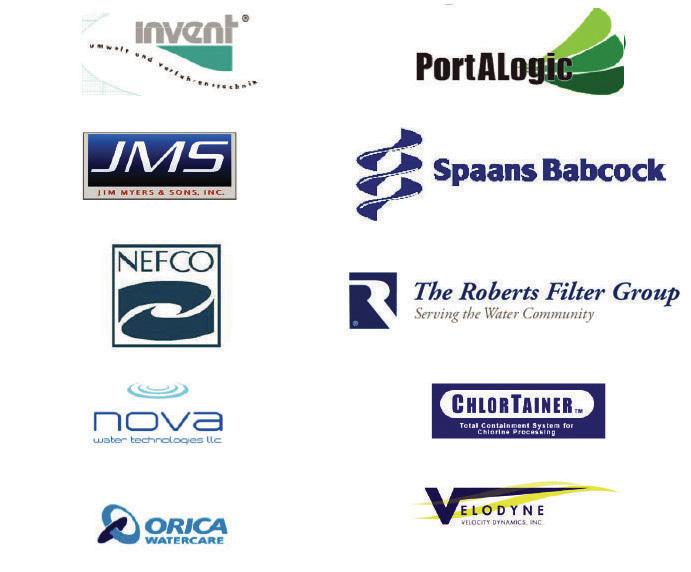



• Blowers – Rotary Screw, Rotary Lobe, Single Stage and Multistage Centrifugal, Turbo, Integrally Geared, Advance Control, Rebuilds
• Aeration – Surface, Membrane & Ceramic, Fine & Coarse Bubble, Gas & Liquid Cleaning, DO Control, AlphaMeter
• Mixers – Anoxic & Swing Zones, Sludge Holding, Digester; Mechanical, Hydraulic and Gas Bubble
• Tank Components –
Decanters, Swivel Joints, Telescoping Covers, Watertight Doors
• Primary & Secondary, Circular, Chain & Flight, Inclined Plate Settlers, Weir Washing
• Rotary Lobe Pumps & Grinders
• Anaerobic Digesters – Sludge Conditioning, In-line Screening, Degritting, Membrane Gas Holders, Liquid Mixing, Nutrient Recovery
• Sludge Drying – Belt, Fluid Bed and Solar
• Septage Receiving – Screens, Dump Stations, Truck Access & ID, data gathering & equipment control
• Sludge Treatment, Transport & Storage – Cake Pumps, Silos, Sliding Frames, Live Bottom Hoppers, Push Floors, Truck Loading, Alkaline Stabilization
• Odour Control – Tank Covers, Chemical & Biological Treatment, Activated Carbon
• – snoitatS pmuP & retawmrotS ,OSC
Tipping Buckets, Bending Weirs, Flushing Gates, Flow Regulating, Vortex Valves, Storm Screens
• Biological – SBR, MBR, RBC, MBBR, MABR, Oxidation Ditch, BioMag, CoMag Polymer – Liquid and Dry Systems
• Digester Gas – Gas Holders, Gas Conditioning: chilling; compressing; and removal of moisture, sulphur, carbon dioxide and siloxane, complete Co-Generation facilities
Most people I have talked to over the years have at least one favourite teacher who possessed the rare talent of being able to combine the roles of educator, guidance councillor, life coach, motivator and friend. I was fortunate to have two such teachers, who both taught history, my favourite subject. One in Grade 7 and one during my high school years.
Regrettably, I never got a chance to thank my Grade 7 history teacher, as we moved away and our paths never crossed again. By chance, however, I did meet my high school history teacher at a social function a few years ago and took the opportunity to thank him. He was quite amused that, for the online security question: “Name of favourite teacher?”, I have always used his last name as my answer.
As we enter the workplace, it is mentors who take on this important role. I was fortunate enough to have two such individuals in my early career. My first was Gerry Nunn, the publisher of Water & Pollution Control Magazine and my first boss. Despite the 35-year age difference between us, he willingly imparted his knowledge of publishing, the water and wastewater industry, and navigating the corporate world, the latter of which I knew nothing about.
My second one was Tom Davey, my father and cofounder of Environmental Science & Engineering Magazine (ES&E). Tom was an award-winning journalist and successful businessman, long before I approached him with the idea of launching ES&E back in 1987. He did not need to take on the workload and financial risk that such a venture created, but to help me, he agreed to do it. If you are reading this, then you know that my idea worked out.
Mentors are special people indeed, who willingly accept the principle of “paying it forward”. I would like to commend and congratulate long-time ES&E Editorial Advisory Board Member William Fernandes, Deputy General Manager of Toronto Water, on receiving this year’s Marcus P. Firman Mentorship Award from the Ontario Water Works Association (OWWA).
Presented at the OWWA’s recent annual conference, this award recognizes an individual who demonstrates exemplary, sustained commitment to mentoring, and inspiring growth and leadership.
The award presentation citation stated that “William Fernandes’ leadership extends across many other organizations, such as the Water Environment Association of Ontario (WEAO), the Canadian Water and Wastewater Association (CWWA) and the International Water Association (IWA). For many years, he has guided

emerging professionals with wisdom, humility, and a deep commitment to their growth. His impact spans from local initiatives to global platforms like the World Water Congress, where he championed inclusive engagement for youth professionals from 17 countries.”
William has also served on the Board of Directors of WEAO and CWWA and he is a former president of CWWA. Recently, he was elected to the IWA Board of Directors, where he is the only Canadian serving on it, and was “instrumental” in bringing the IWA World Water Congress & Exhibition to Toronto in 2024, according to the award nomination form.
“The heart of every successful and resilient water utility is its people. By investing in the growth and potential of others, you can not only strengthen your team but also ensure communities continue to receive safe, critical services,” said William to ES&E
“Mentorship is a powerful reminder that the future of water utilities depends not just on infrastructure, but on the individuals who make it all work,” he added. “I am honored to receive this award and be recognized for my role in mentoring the next generation of professionals.”
I have had the pleasure of working with William on the WEAO Board of Directors, and have enjoyed our chats at countless industry events over the years. On behalf of all those water and wastewater professionals whose lives you have impacted, thank you, William, and please don’t stop anytime soon!
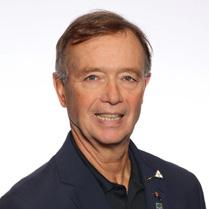
Steve Davey is the editor and publisher of ES&E Magazine. Email: steve@esemag.com
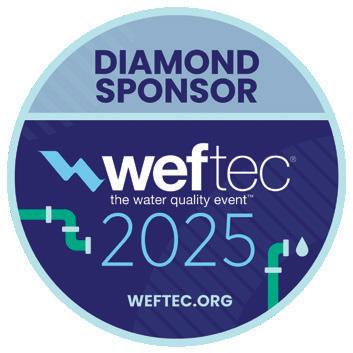



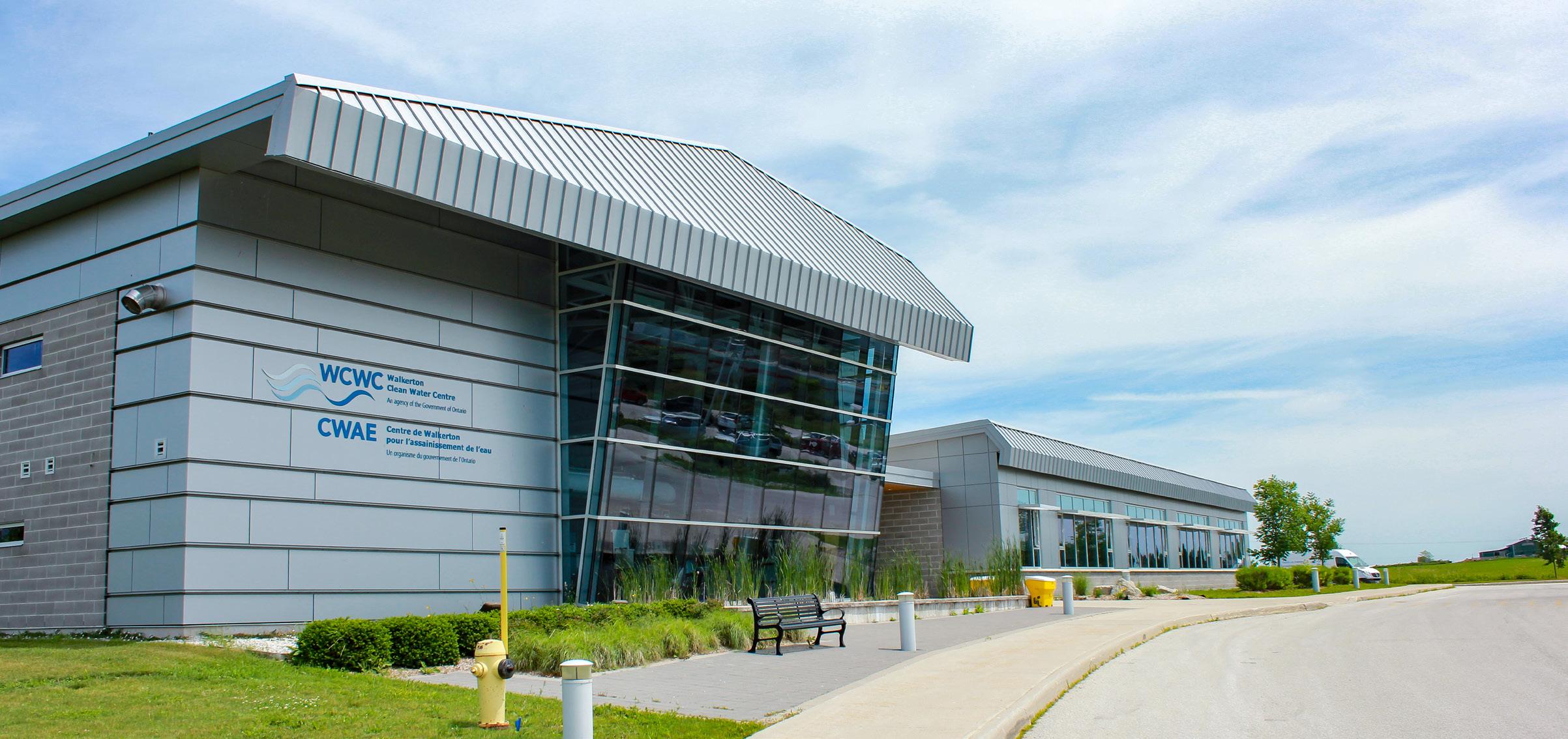
By David Nesseth
Ed Houghton’s nine days on the ground in Walkerton are now something of a blur. But the emotion remains vivid as he recalls becoming the de facto spokesperson for a tragedy that would grip the nation — informing the public and media, one death at a time, of the devastating toll of E. coli-contaminated drinking water.
Now Executive Director of the Ontario Municipal Water Association (OMWA), Houghton was called over the Victoria Day long weekend in 2000 by the Walkerton utility’s general manager, who knew of Houghton’s experience dealing with a cryptosporidium outbreak four years earlier in Collingwood, Ontario. The general manager — who would later be imprisoned for risking public safety — told Houghton a boil water advisory had been issued and that he needed help.
Arriving in Walkerton before sunrise the next day with Collingwood’s water superintendent, Terry “Hock” Hockley,
Houghton quickly grasped the seriousness of the situation. Local hospitals were admitting residents with bloody diarrhea, and the town’s chlorinator wasn’t functioning. Before initiating system flushing, Houghton requested the past 60 days of water sampling and lab reports, as well as distribution system drawings.
“It didn’t take me very long after I started reviewing the reports that I saw a trend, and I saw issues,” Houghton said, during a webinar recognizing the 25th anniversary of the crisis, which was hosted by the Walkerton Clean Water Centre (WCWC) on May 21. “The lab results showed many, many signals that should raise significant red flags, but obviously hadn’t.”
As Houghton discussed flushing plans with Hockley that day, he watched Walkerton Utility Manager Stan Koebel — his eyes red, voice shaking — walk out of the office. It would be the last time Houghton would see him until months later at the Walkerton Inquiry.
“I went from trying to restore the health of the water system with Terry Hockley to becoming the spokesperson for the utility,” Houghton recalls. “I attended all the media events. I was informing everyone what we were doing, and informing the media and the public that we now have the first death, the second death, and so on.”
While Houghton says it’s clear that Koebel and his younger brother Frank — the utility’s foreman — were “certainly neglectful,” the systemic problems went far beyond Walkerton.
“Was Walkerton an anomaly, or were they the norm?” Houghton asked during his webinar presentation. Given the state of technology, funding, and training in 2000, he believes it was, “unfortunately,” closer to the norm for many small municipalities.
As information emerged — from unusually heavy rains to a freshly fertilized cattle farm and the shallow, poorly protected Well 5 — the tragedy became a
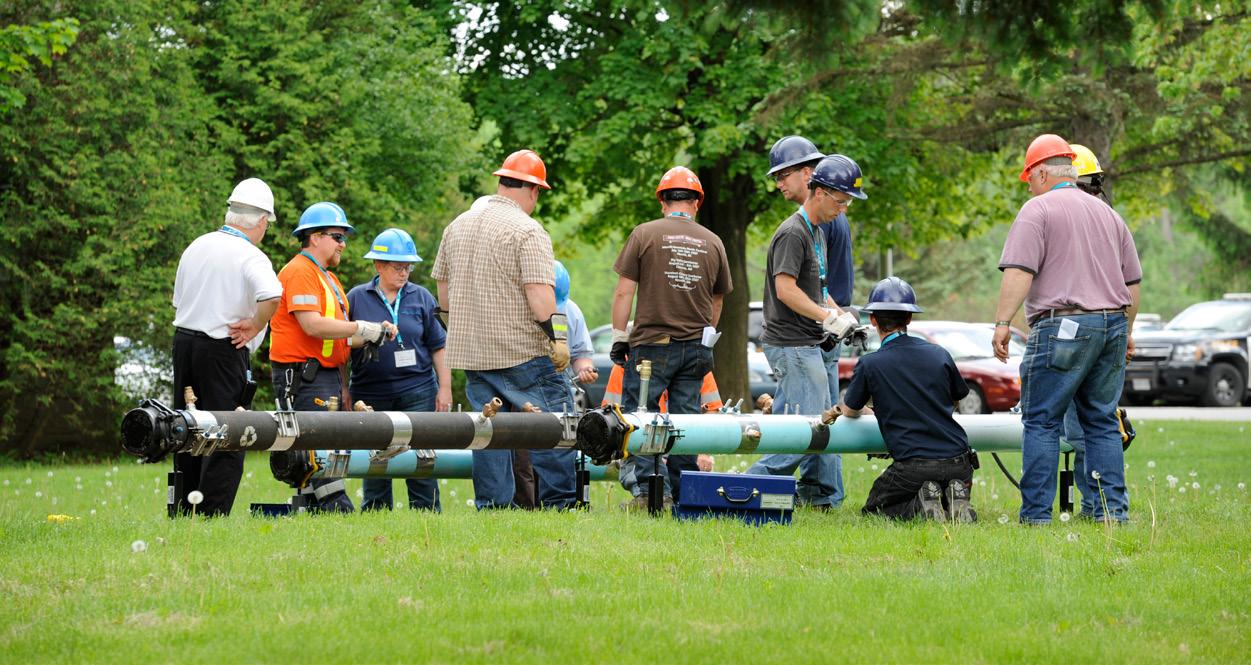
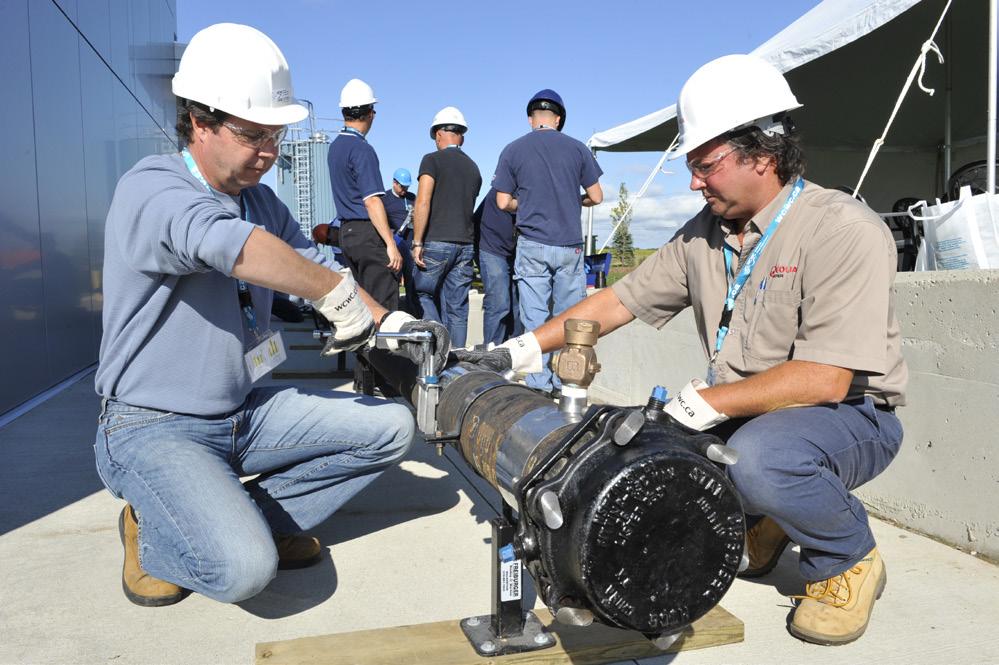
national wake-up call. The Walkerton Inquiry, led by Ontario Associate Chief Justice Dennis O’Connor, would become a pivotal moment in Canadian environmental and public health policy.
Twenty-five years later, the former judge says he still feels the resilience of the Walkerton community, which lost seven people and saw more than 2,300 sickened by drinking manuretainted water.
“It’s one of my strongest lasting memories,” O’Connor tells the WCWC webinar, recalling how eager the community was to find out exactly what had happened. “It was simply the resilience in the community spirit of the people who went through this devastation.”
Central to what went wrong was Well 5, a GUDI well (groundwater under direct influence of surface water) that, O’Connor noted, should never have been approved by the province in 1978.
“Nobody ever revisited it, but it was a dangerous well and an accident waiting to happen — and eventually did,” he says.
Walkerton operators routinely entered identical data into

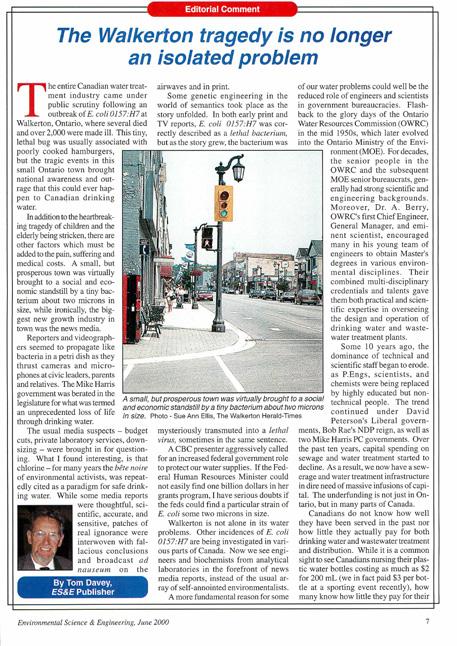
their records, and no one noticed. They skipped required residual checks and based chlorination decisions on public complaints. While O’Connor said the Koebel brothers weren’t bad people and truly “loved their community,” the system had failed them — and everyone else.
“People weren’t trained properly,” O’Connor says. “Everybody tends to focus on the two water operators in Walkerton, but the failures are much wider than that. The failures were throughout the system at every step of the way.”
O’Connor’s 121 recommendations reshaped water protection policy in Ontario. He was satisfied by the academic expertise that formed the recommendations and state-of-the-art best practices, but notes that real safety remains an evolving process.
“Human experience tells us in whatever field we look at that as time goes on circumstances change, and in the case of drinking water, new threats emerge,” O’Connor says.
O’Connor notes that he’s pleased Ontarians can have greater confidence in government based on how they responded to the Walkerton water crisis with the creation of Ontario’s Safe Drinking Water Act (2002) and the Clean Water Act (2006). It was a period in time when guidelines began to shift into legislative requirements, with a sharper focus on system operations. Multi-stakeholder source protection committees were formed and gradually O’Connor’s recommendations began to form Ontario’s drinking water protection framework.
“I take my hat off to the drinking water community for actually developing really sound policy that got implemented because it made sense,” says O’Connor.
His recommendations also led to the creation of the WCWC, which has helped to train thousands of water professionals, and hosted the 25th anniversary discussion for the current crop of water professionals, most of whom would not have been working in the sector at the time.
Brian Bates, the Walkerton Clean Water Centre’s CEO, called the event a “solemn but essential anniversary” as the sector moves from a “reactive” position to a “preventative” one.
David Nesseth is with ES&E Magazine. Email: david@esemag.com
By Mike Sklash and Matt Schroeder
Between 2010 and 2020, there was unprecedented precipitation and storm runoff in the central part of North America. This created numerous problems for municipalities, higher levels of government, industry, and homeowners.
Dragun Corporation was asked to provide expert opinions on the cause(s) of reported flooding during 2016 in a swale on an agricultural property located near Lake Erie. The plaintiff, who purchased the property in 2010, alleged that the defendant, a neighboring manufacturing plant, changed the drainage on their property. This caused more storm runoff to flow in the plaintiff’s swale that, in turn, prevented the plaintiff from easily moving between the east and west sides of his property. The plaintiff alleged that the swale had never previously prevented crossing with farm equipment.
Natural conditions: We investigated the nature of the swale as a natural groundwater discharge area. We inspected the site and interviewed relevant parties familiar with the local drainage. We reviewed historical topographic maps and determined that the swale was a natural groundwater discharge area, receiving groundwater from the higher surrounding areas. Although there were no continuous records of groundwater levels in the watershed of the swale, regional data was consistent with natural and significant increases in groundwater levels since at least 2010. We attributed the higher groundwater levels to increased precipitation during the decade.
Nearby groundwater elevation and lake level monitoring data were consistent with the increase in base flow. These data support the concept of wetter conditions in the swale due to natural conditions.
Changes to the watershed: The defendant expanded their plant, located
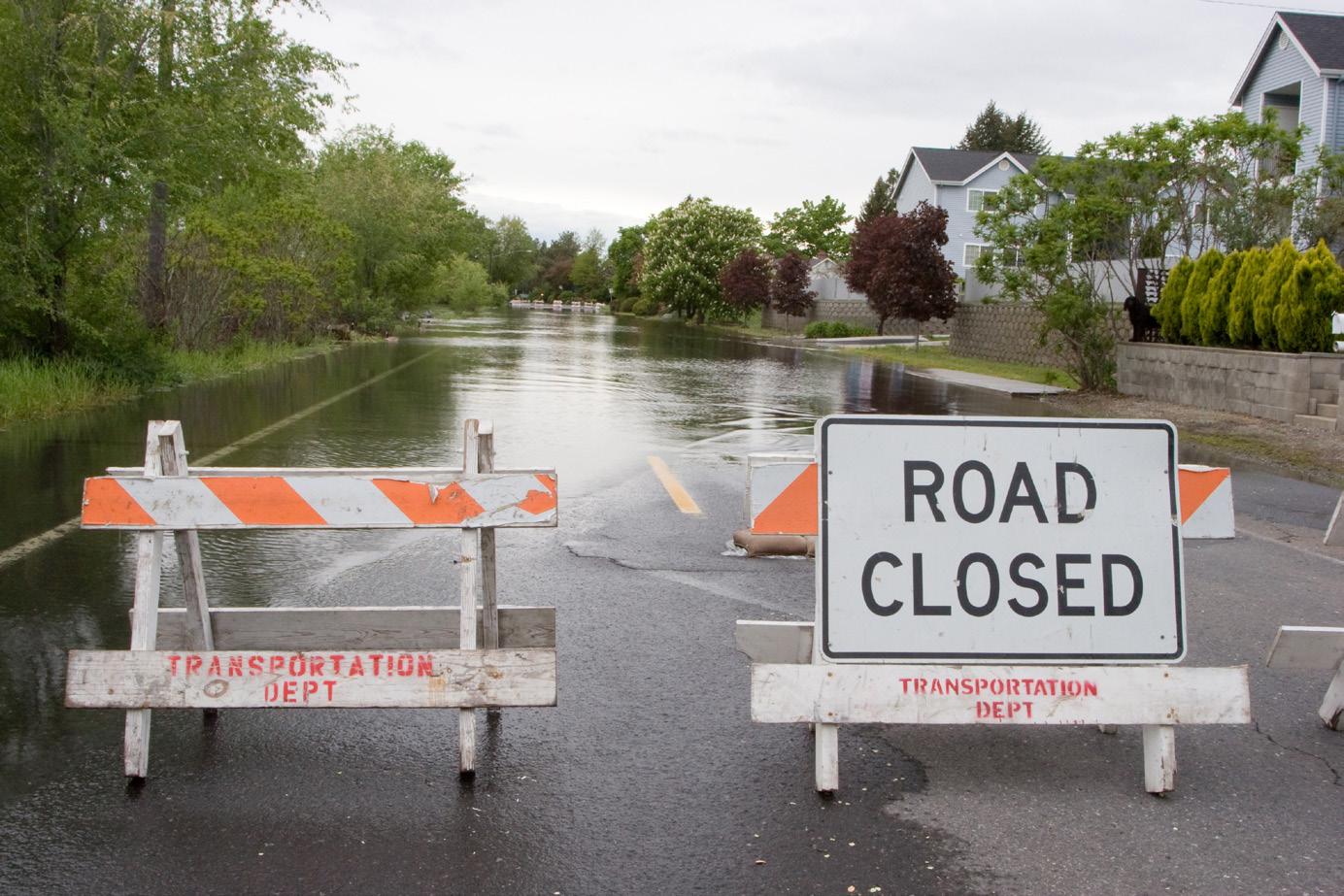
Between 2010 and 2020, there was unprecedented precipitation and storm runoff in the central part of North America. Credit:photogeek,stock adobe.com
north of the plaintiff’s property in early 2016, including the construction of a storm sewer system and a detention pond. Prior to 2016, the defendant’s property naturally had a topographic divide that caused stormwater to flow in opposite directions. However, the plant expansion redirected some stormwater flow from north to south.
The defendant designed their new drainage system to limit stormwater discharge rates to comply with local requirements. The storm sewer system includes a detention pond and all components of the system complied with reasonable and accepted practices for managing stormwater runoff. In fact, the system limits the maximum flow rate to pre-expansion levels and is designed to drain within three days post-storm.
The plaintiff also made drainage alterations on ground sloping to the swale; these changes were intended to facilitate drainage from the slope into the swale. These improvements on the slope actually contributed to greater wetness in
the swale, particularly following precipi tation events. These changes were made both before and after the 2016 construc tion at the defendant site.
Results: The jury quickly determined that our analysis was reasonable; they recognized that the defendant was not responsible for the flooding in the swale. Our analysis indicated that although the defendant’s drainage modifications and the plaintiff’s flooding problem began at about the same time (and that the plaintiff had not experienced these con ditions previously), the two events were unrelated.
The wet conditions along the swale on the plaintiff’s property were caused mostly by its topographic position, regionally wet conditions between 2010 and 2020, and drainage works conducted by the plaintiff on his property.

Dragun Corporation was also asked
WE HAVE AN EASY
INSTALL A SWM SHIELD TO PRE-TREAT YOUR POND

to provide expert opinions on the cause(s) of reported flooding during 2018 at a cottage. The plaintiffs alleged that the defendant increased runoff onto the plaintiffs’ property by reconstructing the lakeside road adjacent to the cottage.
The plaintiffs purchased the property in 2001 and alleged that the property began to flood in 2012. Flooding became severe in 2018 when the roadway was improved. In 2018, the plaintiff’s driveway and garage filled with sediment during storm events.
Two natural conditions exacerbated storm runoff around the cottage. First, the topography around the plaintiff’s cottage based on topographical maps and our site walk observations indicate the cottage was built in a natural groundwater discharge area. This is similar to the analysis in Case Study #1. In Case Study #2, groundwater from higher surrounding areas in the east discharges into the lake and also causes the water table at the cottage to be close to the ground surface. This condition is conducive to storm runoff generation during precipitation. Secondly, the period from 2017 to 2020 was exceptionally wet in this region, with 2019 being the wettest year on record. This increased precipitation led to higher groundwater levels and more runoff.
One of the most obvious indications that the flooding at the cottage was not the result of road work was the sediment load in the storm runoff.
Screen shots from videos the plaintiffs made during one of the flooding events in 2018 showed the following:
• Ponding at the ground surface adjacent to the cottage.
• Storm runoff flowing in the west side “valley” curb on the lakeside road flowing from right to left towards the cottage
• Sediment-laden storm runoff issuing from the unpaved, private road on east side of the lakeside road flowing towards the cottage.
• Sediment-laden storm runoff crossing the lakeside road toward the sandbags that line the entry to the driveway of the plaintiff’s cottage.
The litigation was ultimately resolved by the parties through a private agreement.
In this situation, we were asked to provide expert opinions on reported flooding that flowed from a culvert under an unpaved, rural road in front of the plaintiff’s property. The plaintiff alleged that the flooding in June 2017 was due to storm runoff that moved along, and then under, the rural roadway, through a culvert onto their property. The 600-mm diameter culvert was installed many years before the plaintiff purchased the property.
Two natural conditions help to explain the flooding at this location. First, the topography around the plaintiff’s property,

The wet conditions along the swale on the plaintiff’s property were caused mostly by its topographic position, regionally wet conditions between 2010 and 2020, and drainage works conducted by the plaintiff on his property.
based on topographical maps, wetland maps, and our site walk observations, indicated the property sits in the way of natural surface water drainage. This natural surface water drainage was present long before the plaintiff’s property was developed. Secondly, the watershed was unusually wet during the decade and 2017 was one of the wettest years on record in the area. Both of these factors would promote storm and snowmelt runoff.
Again, the litigation was ultimately resolved by the parties through a private agreement.
Between 2010 and 2020, unprecedented precipitation and storm runoff in the central part of North America created numerous property-related problems associated with excess water. The common thread in these case studies was that the plaintiffs experienced an excess water problem they had never seen before. They claimed the problem originated because of something the defendants did on/near their property.
In situations like this, typical site-specific data such as historical groundwater level measurements and runoff measurements are not available. As a result, we used classical hydrogeological evaluations, such as recharge versus discharge area analysis, baseflow analysis, and historical groundwater and surface water records from various sources. We also examined time trends in precipitation to determine whether natural conditions in the watershed could have been responsible for the excess water.
In some other cases we have worked on, the excess water was self-inflicted. If the property’s water supply is from a deep aquifer and the property uses septic tanks for water disposal, there will be excess water on the property. If the property is developed, changing the amount of impermeable surface on a property, such as roof areas and pavement, will create excess water.
Mike Sklash and Matt Schroeder are with Dragun Corporation. Email: msklash@dragun.com, mschroeder@dragun.com
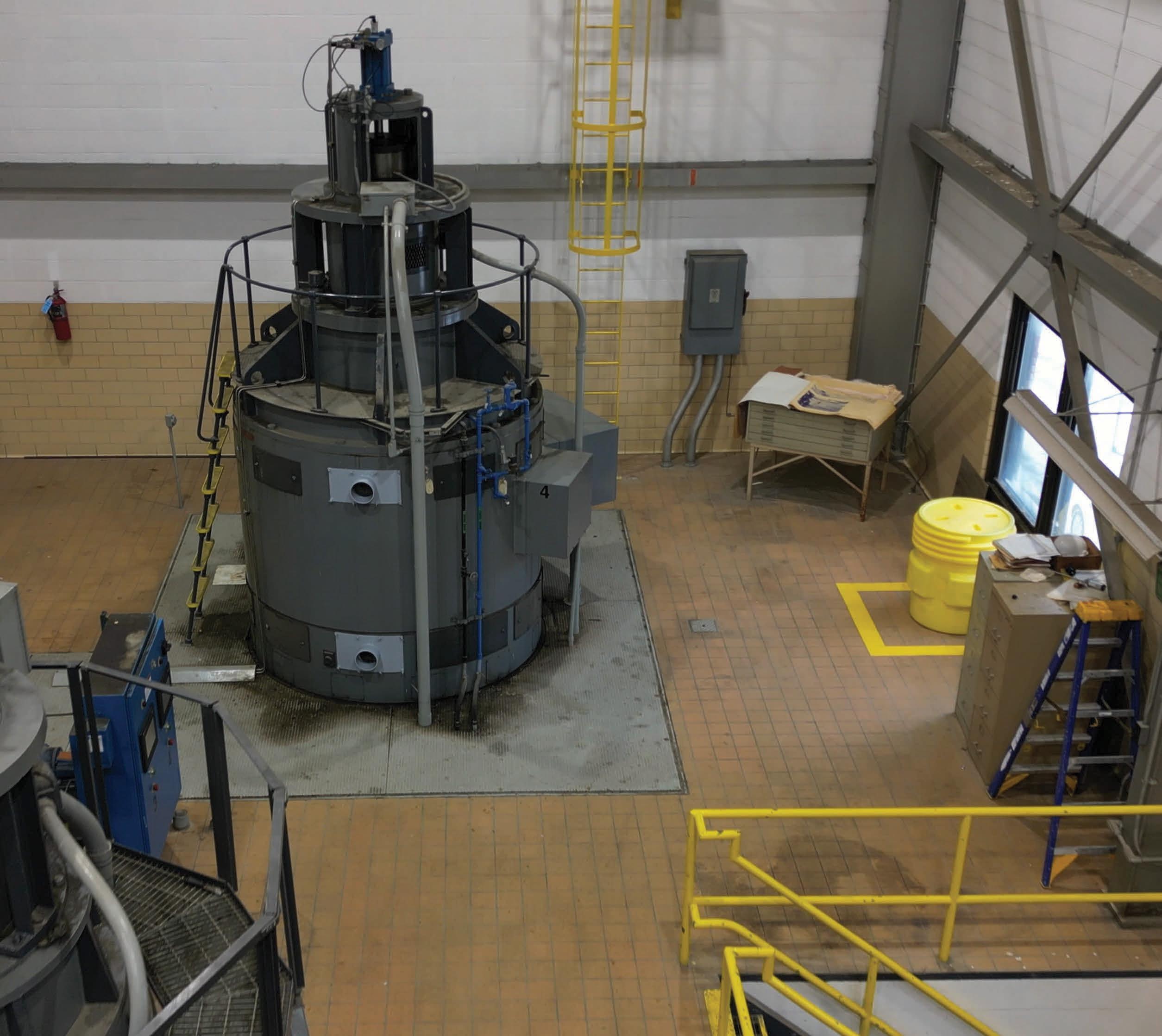
Over 50 years ago, Pentair installed its pumps at the Mill Creek Pumping Station in St. Louis. Today, the city has turned to Pentair to breathe new life into the station.

By Roy Gong and Yang An
Halton Region is a growing municipality of about 600,000 in southern Ontario. It owns and operates seven wastewater treatment plants, as part of its responsibility to provide wastewater management services for the municipality.
Following the construction of a new stand-alone filter building at the Acton Wastewater Treatment Plant, the region wished to retrofit the decommissioned filter building, repurposing the filter wing and combining it with the office wing to create a new administrative building.
This adaptive reuse approach reduces the embodied carbon footprint by minimizing the need for new construction. The region engaged Associated Engineering (AE) to provide engineering services for the filter building retrofit and various plant upgrades. As the prime consultant, AE’s scope of work includes critical elements such as the demolition of the existing process infrastructure, building mechanical services for the retrofitted space, structural retrofit and backfilling of the existing filter tank, and repurposing of the space as offices.
In addition to the retrofit and facility upgrade, the region also wanted to implement energy-saving options to reduce the facility’s environmental impact. Funding is available for green initiatives to support this goal. AE proposed and reviewed several options with the region, and completed a feasibility study to document the viability of potential approaches.
Some of the green initiatives explored to reduce environmental impact included alternative heat sources, such as a
hydronic heating system and geothermal heating. The team also investigated the benefits of upgrading the heating, ventilation, and air conditioning (HVAC) system.
The existing HVAC system for the office area was old and outdated. AE determined the most practical way to serve the retrofitted administrative building was to install roof-top units for conditioning the space. A new HVAC roof-top unit with better energy-efficiency was proposed. Variable air volume boxes are being installed for different rooms to tune the air flow and lower energy consumption when the space is unoccupied.
During preliminary design, the region requested that AE incorporate equity, diversity, and inclusion (EDI) concepts into the design, aligning with their new EDI policy. The EDI design concepts significantly altered the original design, in particular the changing rooms, locker rooms, and showers.
Working closely with the architectural subconsultant, AE developed solutions to minimize the impact on the overall design and re-work efforts. The region acknowledged the scope of these changes and accommodated the additional work required.
During detailed design, the Region asked AE’s team to explore solar thermal wall installation, a technology used to capture and use solar energy to preheat the ventilation air for buildings. Also known as a transpired solar collector, a solar thermal wall is a passive solar heating system designed to reduce the energy required for heating, especially in industrial and commercial buildings. AE’s investigations with a local supplier determined the feasibility of this option.
Roy Gong and Yang An are with Associated Engineering. Email: gongr@ae.ca, any@ae.ca


• No Corrosion or Contamination
• No Chemical Absorption or Wicking
• No Tearing, Cracking or Peeling
• No Significant Abrasion
Each Vanton thermoplastic pump features wet-end components that are inert to corrosive chemicals across the full spectrum of pH, will not contaminate ultra-pure liquids, and are also abrasion resistant.
Handling flows to 1150 gpm (261 m3/h) heads to 185 ft. (56 m) and temperatures to 275o F (135o C), Vanton pumps are ideal for:
• Chemical Transfer
• Neutralization
• Dosing
• Effluent Control

• Lift Stations
• Odor Control
• Recirculation
• OEM Applications
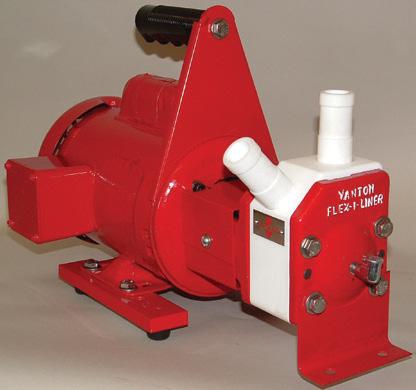
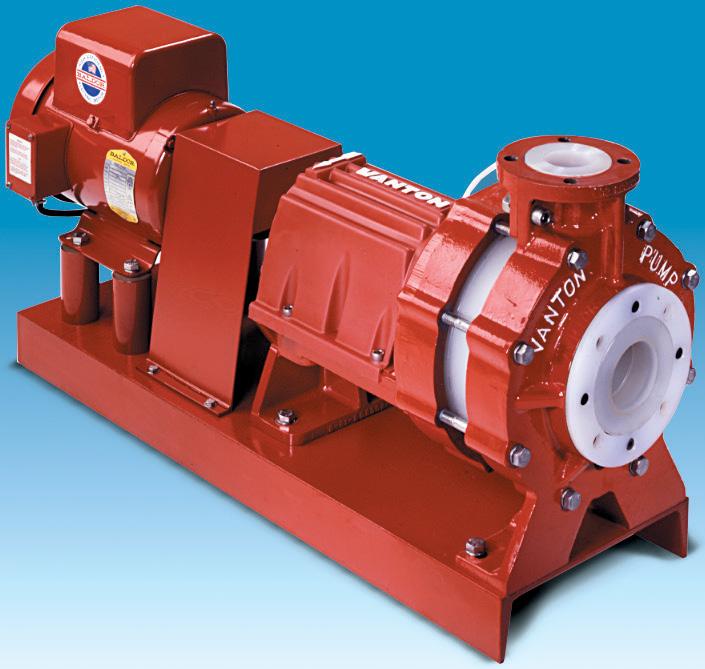

By Ian Lake-Thompson
Toronto is home to many engineering marvels, with its tallest being the CN Tower. However, you may want to look near its base for one of its cooler marvels — The Deep Lake Water Cooling System (DLWC).
To the south of the CN Tower is the John Street Pumping Station, which is the epicentre of this system. However, the DLWC stretches over many kilometers
across the City of Toronto, deep underground and far out into Lake Ontario. The concept is simple, using year-round cold water (4°C) from the bottom of Lake Ontario for district energy cooling. However, its implementation is highly complex.
The Deep Lake Water Cooling System is the world’s largest lake-based system used for district energy system cooling. The City of Toronto and Enwave Energy
Corporation operate it under an energy transfer agreement (ETA) that facilitates the transfer of heat energy from Enwave’s District Energy System to the City’s cold drinking water infrastructure through heat exchangers.
This system came to fruition in the late 1990s, with a number of studies and design activities. A key aspect was the formation of the City of Toronto and Enwave partnership to allow its advance-
ment. Following that, the DLWC system, including three new raw water intakes, was constructed, and commissioned by 2004.
The intakes draw cold water from Lake Ontario to feed the Island Water Treatment Plant’s direct filtration processes. Cold potable water is then transferred to the John Street Pumping Station, where it is pressurized for distribution into Toronto Water’s drinking water distribution system. At the John Street Pumping Station heat exchangers are used to transfer energy between the potable water distribution system and the district energy cooling system.
The primary advantage of the DLWC is efficiency both as a district energy system and through the avoidance of conventional chillers for air conditioning. A key metric is 80% less energy requirement compared to conventional cooling systems such as electrical chillers/air conditioners.

able cooling loads in the District Energy System to the more renewable source of cooling through the DLWC supply.
Since 2004, the DLWC system has serviced a lot of the cooling needs of Toronto. continued
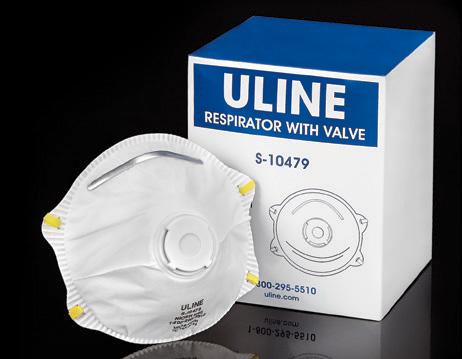


However, there is increasing demand for cooling in Toronto’s downtown core. This has come both from development and the desire to shift from non-renew-


The use of renewable energy sources to provide cooling is a key factor in the City of Toronto’s TransformTO Plan implementation strategy. The goal is to reduce greenhouse gas (GHG) emissions and achieve net-zero. As buildings generate over half of Toronto’s GHG emissions, district energy systems such as Enwave’s district heating and cooling systems, are considered critical components of this strategy.
In 2018, Enwave and the City of Toronto continued their ongoing partnership to initiate a program to complete the Deep Lake Water Cooling Expansion — DLWC-E or Fourth Intake. This continued partnership required consideration of both parties’ requirements to allow project advancement. It also required initial background studies and pre-design to finalize agreements and system funding. Design and construction commenced in 2020, with the system commissioned in early 2024. The expansion work was completed utilizing non-conventional implementation methodologies to help expedite the schedule and obtain partner buy-in.
This also included the subdivision of project elements to allow differing styles of design advancement, procurement and construction, allowing certain elements to be completed as a conventional design-bid-build with other elements as
a contractor-led design-build project.
The expansion now provides additional raw water capacity to the Island Water Treatment Plant and to Enwave Energy Transfer Facilities at the John Street Pumping Station and the Simcoe Street Energy Centre.
The completion of the expansion work also nicely coincided with the 20th anniversary of the Deep Lake Water Cooling System. Not only is the system the world’s largest of its kind, it also has many interesting aspects:
• The deepest tunnel in Toronto, extending to 93 m depth below surface. Constructed in downtown Toronto near the John Street Pumping Station and extending 3 km to Toronto Island near the Island Water Treatment Plant. The Island shaft was constructed primarily in sand and utilized ground freezing to facilitate construction to the tunnel connection. The Island shaft includes permanent works above grade for process equipment and surge control.
• Upgrades at the Island Water Treatment Plant for the additional fourth raw water intake.
• Innovative usage of inactive City infrastructure in the form of the rehabilitation of a 600-m long marine pipeline via offshore sliplining. This also helped to avoid nearshore environmental disturbances.
• A new 3.3 km long 1,600-mm HDPE
pipe installed at a water depth of 70 m via controlled sinking (known as the fourth intake).
• Expansion of pumping and heat transfer equipment at the John Street Pumping Station and the Simcoe Street Energy Centre.
• Over 50,000 m2 of heat exchange area via plate and frame heat exchangers. This would be equivalent to approximately 10 football fields.
• Two megawatts of pumping capacity supplied by four new pumps.
• 251 million litres per day capacity expansion, for a total raw water capacity of 704 million litres per day.
• To date the DLWC has saved nearly 130,000 tCO2e over its lifetime, and 1.7B KWh of electricity.
• The expanded DLWC renewable cooling capacity that offsets over 60 megawatts of electricity generation and reduces demand on the downtown Toronto electrical grid.
Congratulations to Enwave Energy Corporation, City of Toronto, and the whole Deep Lake Water Cooling Team.
Learn more about this system by visiting www.enwave.com
Ian Lake-Thompson is with R.V. Anderson Associates Limited. Email: ilake-thompson@rvanderson.com
By Angelica Pajkovic and Tim Goedeker
Gaskets and packing solutions can play a significant role in advancing sustainable industrial operations by focusing on reducing fugitive emissions from valves and flanged pipe connections. By preventing the escape of volatile organic compounds (VOCs), valve packing, such as Teadit’s 2848 or 2236, helps decrease the overall environmental impact of industrial processes. Proper packing selection results in fewer VOCs released into the atmosphere. Low-emission packings are certified to meet stringent requirements of leakage, with some as low as 2 parts per million.
Reduced emissions also mean lower health and safety risks for on-site personnel, as VOCs can be hazardous when inhaled or exposed over time. This reduction is crucial in minimizing the effect of industrial operations on climate change.
In addition to enhancing safety, these solutions help conserve valuable resources. Preventing VOC leaks avoids the wasting of the materials involved in the production and transport of process media, as well as the energy used to move and process it. By containing these elements within the system, sealing technologies like Teadit’s 913M spiral wound gasket maximize process efficiency and resource utilization, ultimately supporting the industry’s shift toward more sustainable practices.
There are several solutions on the market today that arrest fugitive VOC emissions to well under 100 ppm. Facilities and operations should consider the following:
• How much water is used in the production of the solutions?
• What can be done to reduce the freshwater use footprint?
• Can the amount of freshwater be reduced via recycling or can other types of water — rainwater, treated wastewater —– be used instead of freshwater?
• How much waste is generated in the

Gaskets and packing solutions can play a significant role in advancing sustainable industrial operations by focusing on reducing fugitive emissions from valves and flanged pipe connections Credit: engineer — studio,stock.adobe.com.
Preventing VOC leaks avoids the wasting of the materials involved in the production and transport of process media, as well as the energy used to move and process it.
production of the solutions?
• What can be done to reduce the footprint of waste generated?
• Can packaging be reduced to avoid excess waste?
• How is nature (land primarily) impacted by the production of the solutions?
• If fugitive emission solutions use
minerals from the earth, are there other minerals that could be used to produce an equivalent product with less impact on nature, i.e., less invasive mining or mineral capture processes.
Sustainability is not just the use and care of air, but also the use of water, the disposal of wastewater, the creation of waste, and care of nature and biodiversity. As the common goal is sealing for a safer and greener tomorrow, it is important that the world begin to understand and adopt sustainable practices while manufacturing products, such as gaskets and packing, that aim to increase sustainability.
Proactive sealing manufacturers with increasingly efficient, reliable, and responsible processes should be constantly looking for ways to reduce their impact on the environment and the earth.
Angelica Pajkovic and Tim Goedeker are with Teadit. Email angelicap@teadit.com.
By Paula Campbell
As spring runoff begins to flow through Alberta’s valleys, it reminds us of the important role groundwater plays across the landscape. The annual snowmelt influences Ducks Unlimited Canada (DUC) projects in Alberta and impacts our communities through the seasons ahead.
Groundwater is a vital resource for agricultural communities, supplying clean water for crops, livestock, and other farm operations. Many households and municipalities rely on strong groundwater reserves for drinking water and to maintain lake levels and river flows. Groundwater is essential to Indigenous communities, maintaining water levels and flows that sustain the land. It is a sacred element of traditional life and knowledge, connecting people across generations, and foundational to sanctuaries where wildlife and people can thrive harmoniously.
Groundwater resides beneath the Earth’s surface, filling cracks and spaces in soil, sand and rock. It occurs in underground formations called aquifers and is frequently a crucial source of fresh water. Rain and snowmelt percolating through the soil replenish groundwater, which naturally reemerges through springs, rivers and wetlands. This water plays a key role in the global water cycle, contributing to ecosystem health and sustaining life. However, groundwater faces increasingly challenging conditions, putting essential drinking water, ecosystems and the environment at risk.
“Depletion of groundwater has occurred over time largely due to the ongoing development of natural landscapes like grasslands and forests, or the draining of wetlands. Wetland loss disrupts their natural recharge function and can lead to declining groundwater levels, potentially affecting availability and qual -

ity for other uses,” says Pascal Badiou, research scientist with DUC. “Climate change can also deplete groundwater through increased evapotranspiration and decreased recharge, while impacts on precipitation patterns and how those related to groundwater recharge tend to be more variable,” Badiou shares.
These challenges pose a risk to the livelihood of Albertans in so many ways; however, wetlands help mitigate many of these challenges. DUC is dedicated to keeping and restoring wetlands on working landscapes, ensuring they continue to support groundwater security. As nature’s multitaskers, there is no better nature-based solution for the job!
Because wetlands are depressions on the landscape, they collect water and form an essential component of an area’s water regulation. They are connected to water underground, helping to recharge groundwater and aquifers.
As water drains into a wetland, it is filtered, while bacteria in soils and sed-
iments help break down contaminants. Once the water settles into a wetland, it is absorbed in the saturated sediment on the bottom, further filtering the water before slowly releasing it to groundwater aquifers or surface streams, helping to ensure sustainable water resources during periods of drought and unreliable water supply.
“While we generally work with small isolated mineral wetlands like prairie potholes, these can still be hydrologically connected to other wetlands and downstream waterbodies through groundwater,” says Badiou.
Badiou explains, “Ali and Creed’s (2017) modeling work in Alberta showed that prairie pothole wetlands are not hydrologically isolated and that the surface and subsurface hydrologic connections vary significantly in terms of their timing and length. These contributions can be substantial regardless of the wetland’s location in the watershed, and the volume flowing through can be comparable to those associated with surface water connections.”
Through partnerships with land stewards and its diverse conservation programs, DUC has indirectly contributed to groundwater storage and filtration while enabling delivery of other ecosystem services that support many different people, places and wildlife in Alberta. Key impacts include managing 1,690 basins that store 1.6 billion m³ of water. This is the equivalent to 90 Glenmore Reservoirs or 640,000 Olympic-sized swimming pools.
Millions of dollars have been invested in initiatives like wetland restoration, forage programs, and conservation easements to restore and enhance water filtration, groundwater recharge, and wildlife habitat.
Since 1938, DUC has conserved 2.3 million acres across Canada, focusing on restoring wetlands and grasslands to sustain biodiversity and counter habitat loss. By working with partners and land


stewards, DUC ensures wetlands remain on the working landscape, supporting clean water, climate resilience and sustainable livelihoods.
Paula Campbell is with Ducks Unlimited Canada. To learn more about DUC projects, visit: www.ducks.ca


By Jeanne Hendrickson
Chemical metering pumps are used in water treatment plants to deliver precise volumes of sodium hypochlorite, peracetic acid and other disinfectants into the systems. Depending on the type of pump, the chemical being dosed, and other circumstances, operators can experience vapour locking.
This phenomenon occurs when gases, typically formed due to the volatility of certain chemicals, accumulate within the pump head. Because gas is compressible, it doesn’t allow for the proper movement of liquid. This creates a blockage, which can result in an improper dose or no dose at all. It may even stop the pump. Several factors contribute to vapour locking in chemical metering pumps. Chemicals that off-gas or vapourize can create air pockets that can cause vapour locking. Sodium hypochlorite, for example, is known to release chlorine gas when it breaks down.
Some liquids that remain stable at room temperature can vapourize when temperatures increase too much. This is particularly problematic in warmer climates or with pumps that have motors which generate too much heat during operation.
A high suction lift, or insufficient inlet pressure, can also promote vapour locking. When the pressure at the pump’s inlet drops below the vapour pressure of the fluid, the liquid turns into gas, creating a blockage before the fluid even enters the pump.
Choosing an oversized pump can also contribute to vapour lock. If a pump is too large for the system’s needs or if it’s running too slowly, gas can accumulate in the pump head without being pushed through.
The short-term effects of vapour locking are often immediately noticeable. When it occurs, the pump either

Depending on the application, operators could use peristaltic metering pumps, such as these ones from Blue-White Industries, rather than a diaphragm pump.
stops injecting fluid entirely, or it fails to deliver the required dose of chemicals. This can lead to significant disruptions in the disinfection process, potentially compromising water quality and safety.
In the long term, prolonged exposure to gas buildup can cause wear and tear on pump components, including seals and diaphragms. In extreme cases, it may also lead to pump failure, requiring costly repairs or replacements. In addition, vapour lock can damage the integrity of the entire chemical dosing system, which can result in downtime and increase maintenance costs.
While vapour locking is a serious concern, there are several strategies and technologies available to mitigate its impact and ensure continued system performance.
Some pump manufacturers offer auto degassing valves to combat vapour locking. These are designed to allow trapped air to escape from the pump head without letting the liquid leak out. The valve automatically opens as air accumulates, releasing the gas and allowing the pump to continue pumping.
Auto priming is an advanced software feature, which is available on some diaphragm pumps. It will detect when no fluid is being injected and automatically adjust the pumping operation to prime the pump. By running the pump at a higher speed for a short burst, the auto
prime function helps expel air from the system and restore proper fluid flow.
As mentioned earlier, using an oversized pump that is running too slow can create vapour locking as fluid spends too much time inside the pump’s chambers. Using a smaller pump running at a higher speed could help to minimize gas accumulation.
Depending on the application, operators could use a peristaltic metering pump rather than a diaphragm pump. Peristaltic pumps are very effective when dosing fluids that contain trapped gases because they are not affected by air bubbles. They simply pass through the pump tube. There is no vapour lock and no loss of prime. However, peristaltic pumps are not always a good choice in high pressure applications.
Older pumps prone to issues of vapour locking can often be upgraded with aftermarket degassing valves. In other cases, operators can switch to a more suitable pump design. Another option involves regular maintenance, such as checking for leaks and ensuring that seals are intact. These simple procedures can extend the lifespan of the pump, improve overall performance, and reduce instances of vapour locking.
Vapour locking can be a challenge with chemical metering pumps, but it is not insurmountable. By understanding the causes and consequences of vapour lock, operators can take proactive measures to prevent it, including utilizing advanced valve technologies, optimizing pump operation, and maintaining proper system design.
By addressing vapour locking effectively, water treatment plants can ensure the continued reliability and efficiency of their chemical dosing systems, ultimately helping to maintain the safety and quality of treated water.
Jeanne Hendrickson is with Blue-White Industries. Email: jeanne@bwadvertising.com
1.8 billion people lack access to clean water
2.5 billion people—more than a third of the world’s population —lack access to a toilet
Women and children spend 200 million hours a day collecting water

Hygienic practices such as washing hands with soap can reduce the risk of diarrhea by at least 35%
More than 3.4 million people each year die from water related diseases—that’s nearly the population of LA
Nearly 90% of global cases of diarrhea are estimated to be attributable to unsafe drinking water, inadequate sanitation and poor hygiene
is
We’re taking big steps to solve the world’s water crisis—permanently. We want complete water coverage for every family, every school, and every clinic. And we’re teaming up with Everyone to make this difference last Forever.
Water For People brings together local entrepreneurs, civil society, governments, and communities to establish creative, collaborative solutions that allow people to build and maintain their own reliable and safe water systems. We’re not just addressing the symptoms of the problem, but preventing it from happening again in the future.
The road to permanent water coverage for Everyone Forever is challenging. If we invest more now to create sustainable and replicable water and sanitation infrastructure, we can achieve incredible outcomes—more children are in school, more individuals are employed, more families are healthy and thriving, and more communities are collaborating and growing. From there, the impact continues to ripple out on a national and global scale.

By Jim Caruso
Often overlooked, the small, nondescript desiccant cartridge is an important component in maintaining the performance and operation of electronics associated with flow measurement instrumentation, much of which is submerged within water or wastewater flow (or close to it).
But can that tiny dehumidifying packet truly have such a profound impact on the condition and performance of flow meter electronics and sensors? When utility managers and technicians rely on real-time, accurate flow data to maintain compliance, make informed decisions about daily operations, and potentially bill for water usage, fouled electronics have significant consequences.
Flow instrumentation often contains a desiccant cartridge, or drying agent, within the electronics to remove any moisture that may have entered the unit during the manufacturing process. Additionally, this safeguard is in place to protect the unit when the customer replaces the batteries or opens the unit for maintenance purposes.
For open channel flow instrumentation such as level sensors, bubblers, or flow loggers, the desiccant cartridge is in-line with the vent tube. The vent tube allows the pressure transducer to isolate the pressure imparted by the water and negates the pressure contributed by atmosphere.
Without a free-flowing tube, the pressure transducer would see the pressure from the water depth and the weight of atmosphere. Atmospheric pressure changes with the weather; note that your local weatherperson says the pressure is rising or falling, and this is what is being referred to. In the case of a submerged area velocity sensor, a pressure transducer in the sensor converts the pressure the water places on the transduce of the water to a level measurement.
A desiccant cartridge attached to the cable and in-line with the vent is located near the flow logger and is positioned vertically with the end cap pointed down, so the atmospheric pressure reference is protected from moisture entrapment.
Put simply, a desiccant or drying agent ensures proper operation of the flow instrumentation. If the desiccant isn’t included, or is not properly maintained, moisture will alter the integrity of the flow and level readings.
In open channel applications such as wastewater or stormwater channels, high humidity and surcharge are inevitable, threatening flow and level measurement equipment. Should condensing moisture intrude and block the reference air tube,

A diagram identifying the desiccant cartridge on the FLO-DAR® Area Velocity sensor. Courtesy of McCrometer
the level transducer will produce readings that drift from the device’s usual accuracy.
In addition to fouling, a depleted desiccant is the most common cause of level drift. Inaccurate, untrustworthy flow and sensor data will prevent wastewater professionals from making informed decisions about their collection system.
DESICCANT CARTRIDGE BEST PRACTICES
Each desiccant cartridge will need to be refilled at some point during the lifespan of the flow instrument, but the frequency will depend upon the flow application, location, seasonality, and surcharges.
If the installation is in a humid, contained location such as a manhole measuring wastewater flows, technicians may find that the desiccant requires replacing more frequently.
Certain environments are more humid or arid than others. Flow applications in dry locations may require less frequent cartridge replacement than applications in humid subtropical environments, especially if exposed to the elements rather than contained within a manhole.
Technicians and operators may find that desiccant cartridges need more frequent replacing during the rainy season or during months with higher humidity levels. After wet weather events, a site visit is suggested to ensure proper functionality and performance of the flow devices is maintained, which may include desiccant replacement. This is especially important when surcharges have occurred at the installation site.
Wastewater professionals who have numerous installation sites to maintain may find it difficult to visit each device frequently enough to sufficiently inspect the desiccant cartridge for necessary replacement. Flow and level devices don’t contain alarms to notify users when the desiccant needs replac-


Whole-network CCTV sewer line assessment is very costly and is a slow process Rapid Assessment Technology Services (RATS Inc.) has redefined the assessment process by providing municipalities with comprehensive acoustic network condition data in a fraction of the time and cost required by the old, costly CCTV methods


Our patented acoustic technology provides real-time blockage assessments and records the condition of approximately 3,000 Meters of 150-450 mm gravity sewer lines per day Using the most commonly used mapping and database platforms, Municipalities receive a whole-network map and condition report pinpointing the areas which require the more expensive and resource intensive CCTV and repair crews only where needed – usually less than 25% of the entire network!
Ontario municipalities now can focus their high-cost resources only on the small percentage of the network that represents a potential service disruption or hazard to the community.
To find out how using RATS will result in lower overall project costs and annual required maintenance completed in less time, contact RATS today.
ing and rely wholly on visual inspection to determine if maintenance is required. Technicians can double up on desiccant cartridges and daisy chain them together to safeguard their device for longer periods of time before scheduling routine maintenance.
However, best practices state that users should visually inspect the desiccant cartridge during each site visit and develop a unique maintenance schedule based on the needs of that installation site and the instrumentation installed.
While installing multiple desiccant cartridges is an added level of protection, it doesn’t eliminate the need for manual inspection and a dedicated maintenance schedule. Should technicians and operators fail to maintain their flow devices’ desiccant cartridges and withhold site visits, their indication for needed maintenance would be in the form of level readings beginning to drift.
With enough time, irreversible damage to the sensor would occur, causing a



complete loss of real-time, accurate data, plus the cost to replace and install new flow instrumentation.
A dehumidifying cartridge or drying agent, as insignificant as it seems compared to the essential role of a level sensor or flow meter, contributes substantially to accurate, repeatable flow data. Even one droplet of water can interfere with the performance of flow and sensor equipment, producing erroneous readings. The difference between 100 mm and 112 mm of water doesn’t seem significant, but when moving at a high velocity, it’s a sizeable amount of water not being properly accounted for by flow devices.
Water and wastewater professionals often have an overwhelming pipeline network and a bevy of instrumentation to maintain. Visiting each installation site can take time away from other import-
ant, higher priority tasks, especially for a smaller municipality or one with limited “boots-on-the-ground” personnel.
One program exists to help water and wastewater professionals with ongoing maintenance of their flow instrumentation, specifically for McCrometer’s FLODAR area velocity sensor. This comprehensive service repair program is designed to keep flow monitoring equipment operating at peak performance, whether a unit requires routine maintenance or a complete repair.
In addition to sensor diagnostics, verification of measurement readings, and instrument cleaning, this service includes replacement of the unit’s desiccant cartridges to protect against moisture damage and ultimately extend the lifespan of the device.
Jim Caruso is with Hach’s Flow Solutions by McCrometer, who have representatives across Canada. Email: james.caruso@mccrometer.com










Thank you to everyone who participated in this year’s CANECT Environmental Compliance and Due Diligence Training Event. We look forward to seeing you at CANECT 2026!
SPONSORS & PARTNERS


COURSE CHAIR COMPANIES

EXHIBITORS
Bureau Veritas
CADUCEON Environmental Laboratories
CM3 Environmental Inc.
Dragun Corporation



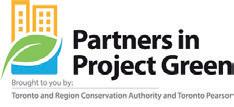

eCycle Solutions Inc.
LimeGREEN Equipment Inc.
OACETT
Resource Productivity and Recovery Authority

Testmark Laboratories
Trinity Consultants
Tri-Phase Group
Vector Process Equipment Inc.
By Mike Hewitt
Operators Without Borders (OWB), a Vancouverbased charity, has emerged as a key player in global water and wastewater management, offering technical support, training, and disaster recovery services to regions affected by both conflict and environmental disasters. Founded in 2017 by Valerie Jenkinson in response to critical needs in the Caribbean following Hurricanes Irma and Maria, OWB’s mission centres on capacity building, sustainability, and the restoration of water services. Since its inception, the organization has trained over 500 professionals and delivered services valued at nearly $2 million globally.
The roots of OWB were planted in the aftermath of the catastrophic hurricanes that devastated the Caribbean in 2017. Bernard Ettinoffe, the general manager of the Dominica Water and Sewerage Company (DOWASCO), reached out for skilled assistance to restore water and wastewater services. In response, Jenkinson rallied a group of certified water operators from Canada and the United States to assist in recovery efforts. This collaboration laid the foundation for what would grow into a global organization, addressing broader water management challenges, particularly in disaster preparedness and recovery.
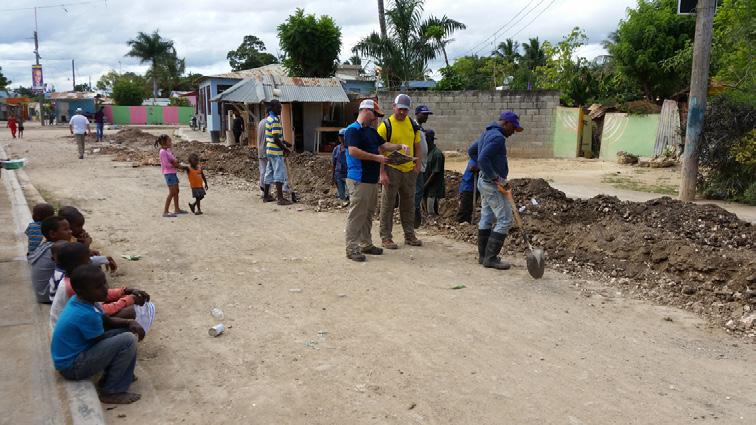

OWB’s impact in Ukraine has been profound, as the ongoing conflict has targeted essential water infrastructure, leaving utilities in a state of crisis. Despite the dire conditions, OWB has been providing virtual and remote assistance, including in-person training at Gdansk, Poland.
One of the organization’s key interventions has been the delivery of Incident Command System (ICS) training to more than 500 Ukrainian and Polish water professionals. These workshops have helped operators manage and respond to the continuous threats posed by the conflict, particularly in the aftermath of the Kakhovka Dam destruction.
In addition to ICS training, OWB has focused on chemical, biological, radiological, and nuclear (CBRN) contamination of water supplies, a pressing concern given the heightened risk of environmental contamination. OWB also provided trenching safety and water quality safety programs, including a “train the trainer” initiative, which ensures that local trainers can cascade essential knowledge to their colleagues in the field.
Moving forward, OWB plans to expand its training programs, including specialized workshops on water quality safety and lagoon revitalization, to further bolster Ukraine’s ability to recover and rebuild its critical water infrastructure.
OWB’s reach extends far beyond Ukraine, with a significant
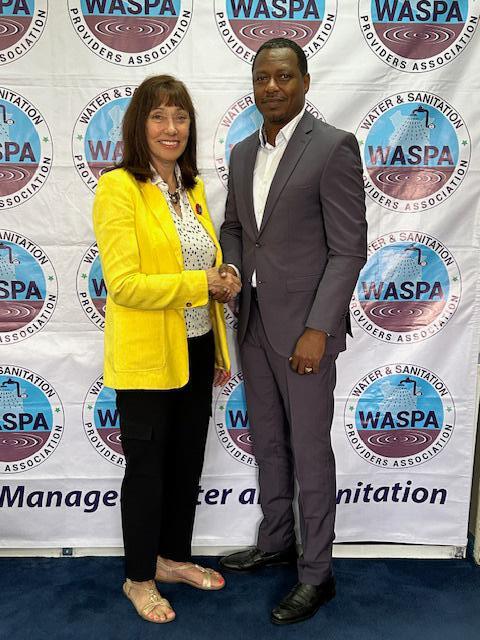

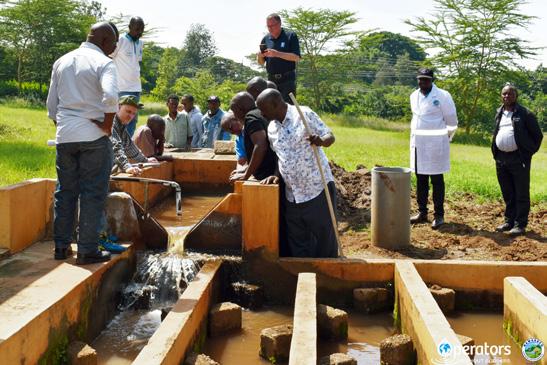
focus on Africa. In Kenya, OWB has worked closely with the Nakuru Water and Sanitation Services Company (NAWASSCO) to deliver certified training for water distribution and wastewater collection operators. This initiative, which is part of a UN Habitat and Global Wastewater Initiative (GWI) pilot project, has already led to the certification of the first six Kenyan operators, a critical step in strengthening local water management capabilities.
In collaboration with the Kenya Water Institute (KEWI) and the Water and Sanitation Providers Association (WASPA), OWB is promoting the use of decentralized wastewater treatment systems and innovative technologies, such as biogas recovery and digital water monitoring. These efforts aim to reduce the reliance on centralized systems, which are often less efficient in rural and remote areas.
Additionally, OWB has worked across other parts of Africa, including Nigeria and South Africa, addressing aging infrastructure, non-revenue water losses, and limited regulatory enforcement. OWB’s technical expertise, combined with its strong local partnerships, has laid the groundwork for sustainable water management solutions that are both innovative and scalable.
OWB has also been instrumental in providing support across the Caribbean and Latin America. Following the destruction wrought by Hurricane Dorian in the Bahamas, OWB deployed teams to assist with water quality management and safety repairs to wastewater treatment plants.
Similarly, in Haiti, OWB’s HANWASH initiative successfully reduced non-revenue water levels in Pignon from 80% to 35%, a remarkable achievement that highlights the potential of targeted capacity-building programs.
In Latin America, OWB has worked with AySA in Argentina to address wastewater effluent issues and has partnered with Caribbean utilities to provide ICS and safety training. These programs not only bolster emergency response efforts but also contribute to long-term resilience by enhancing the technical skills of local water professionals.
Despite its successes, OWB faces numerous challenges, including logistical complexities, cultural differences, and varying local conditions. However, the organization has overcome these hurdles by building strong local partnerships, tailoring its interventions to meet the unique needs of each region, and emphasizing mentorship and long-term capacity building.
Looking ahead, OWB is focused on expanding its global presence, particularly through the launch of OWB Australia, which will serve as a hub for water and wastewater projects across Asia and the Pacific. Additionally, OWB is preparing for future disaster response initiatives, particularly in the Caribbean, and aims to become a full UNICEF Standby Partner, which would further enhance its ability to respond to global emergencies.
OWB’s work relies on the dedication of its volunteers and
OWB’s impact in Ukraine has been profound, as the ongoing conflict has targeted essential water infrastructure, leaving utilities in a state of crisis.
the support of individuals and organizations who share its commitment to sustainable water and wastewater solutions. Volunteers with relevant expertise are crucial to the success of OWB’s programs, and donations help fund operational expenses, including travel and accommodation costs for volunteers. Individuals can also become members of OWB, with membership fees contributing directly to the organization’s initiatives. To learn more about how you can get involved or support OWB, visit www.operatorswithoutborders.org, or email: info@operatorswithoutborders.org.
Mike Hewitt is with Almaquin Enterprises Limited and volunteers with Operators Without Borders. Email: mike@almaquin.com






For years, sewer maintenance crews have been taught to shoot a nozzle up a line in a hurry and clean as they come back. But this is not a race. If you are not slowing down to cover all the ground, it simply is not going to work very well, according to Dan Story, a trainer and operations manager at KEG Technologies. Instead, he trains sewer crews to clean as you go in and rinse as you come out.
“With this approach, 95% of the time you will clean a line in one pass instead of making many passes,” says Story, who travels across Canada conducting training on sewer cleaning techniques.
He says you can learn a lot by paying attention to what is happening in the line going in and coming back. “Crews need to be trained to understand what they are ‘reading’ coming out of the pipe. The information can tell you whether you are going too fast or too slow, how much debris is in the line, and whether the line is clean after the first pass, or not,” he says
When going up the line, for example,
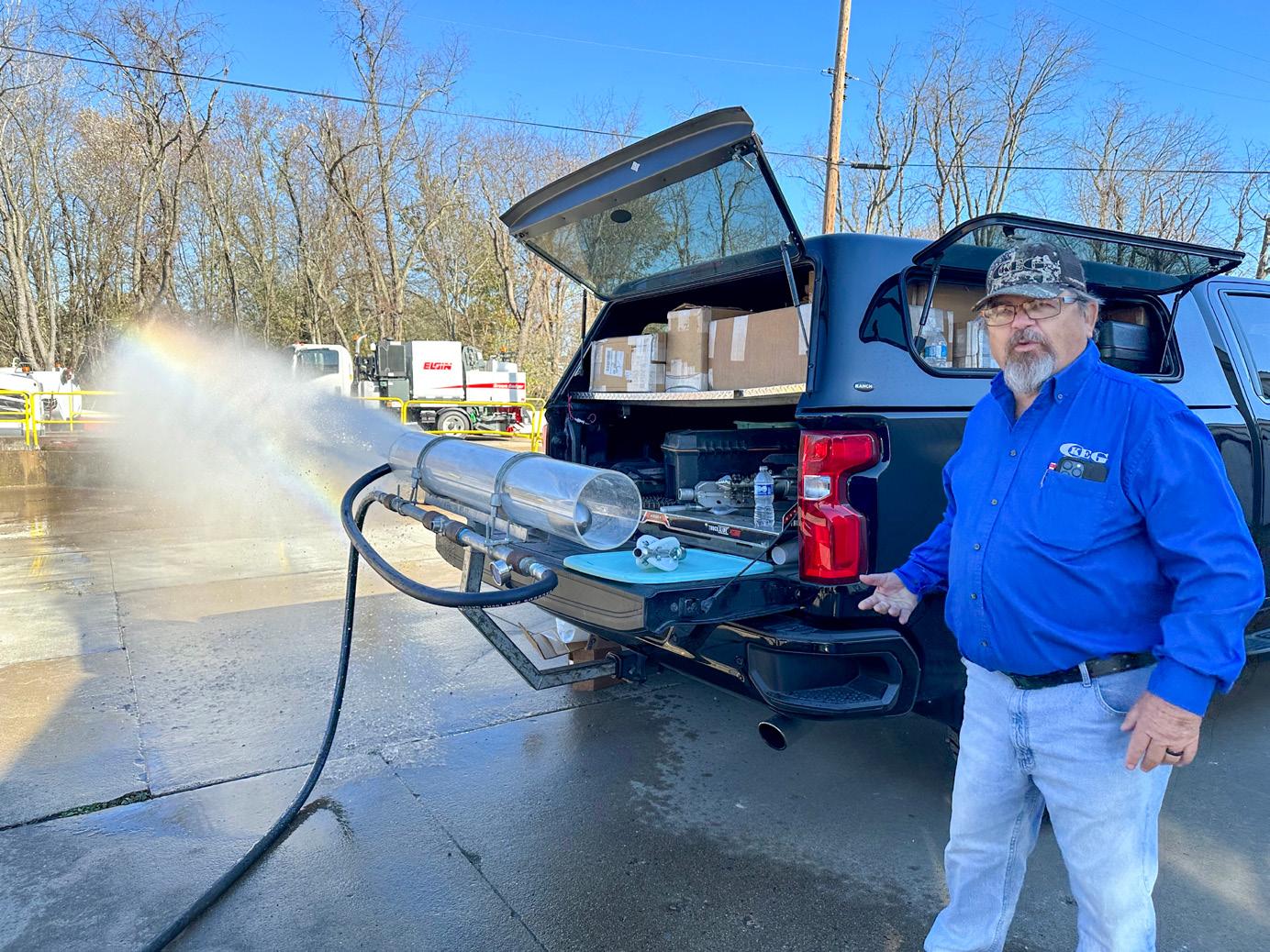
it is beneficial to observe the amount of debris present. If there is minimal debris returning, it indicates that the
pipe is in relatively good condition, with a low accumulation of debris. So, operators can accelerate their cleaning speed.

An employee-owned company, Associated Engineering fosters collaboration and teamwork, and promotes professional and personal growth. We have immediate openings for the following positions:
• Project Managers - All Offices
• Civil Engineers & Technologists - All Offices
• Agricultural Ecologist - Vernon
• Environmental Scientists - Regina, Yellowknife
• Water Resources Engineers - Vancouver, Victoria, Kelowna, Calgary
• Wildlife Biologists - Calgary, Saskatoon
To apply and for information on these and other opportunities in our offices across Canada, visit ae.ca/careers
However, an excessive amount of recovered material suggests the need to slow down. In such cases, the flow of water acts as a conveyor belt, effectively carrying the debris out.
When the water flow confirms the pipe has been cleaned at the right speed, the maintenance crew can then lower the pressure in the hose to between 900 – 1,000 PSI and come back through the pipe at the same speed. This final single “rinsing” pass can leave the line totally clean.
A common sewer cleaning misconception is that you don’t need to open the upstream manhole when cleaning sewer pipes. This can actually increase pressure in the system and lead to blown toilets, where sewer gases flow up the laterals and cause sewage water to overflow from residential toilets. According to Story, approximately 95% of blown toilets can be attributed to how the operator cleans the lines.
Slowing down and observing the results allows for cleaning to be performed in a single pass, which helps safeguard the hose from potential damage. “If you are going into each pipe once, rather than three times, to clean it, you are basically tripling the life of a three to four thousand dollar hose,” says Story. Beyond the wear and tear on the equipment there are also operational costs to consider, such as water, fuel, as well as the productivity of the operators. “Cleaning more efficiently and effectively means lowering the operating costs per pipe and increasing what a city’s public works department can do,” explains Story.
Story cautions departments not to overlook the importance of nozzles, even when expensive trucks are purchased for providing a water supply. While a department may have invested a half-million dollars for a truck to clean sewer lines, its impact is only as good as the nozzle at the end of the hose. There are tiers of nozzles which are rated for water efficiency from Tier 1 (about 30% efficient), Tier 2 (50-60% efficient), to Tier 3 (75-98% efficient).
Approximately 95% of blown toilets can be attributed to how the operator cleans the lines.
According to Story, a Tier-1, 30-degree drilled nozzle, running 275 litres per minute at 2,200 PSI, will only exert 13 pounds of force to move debris three metres away from it. In contrast, a very high-efficiency Tier-3 nozzle, running 230 litres per minute at 2,000 PSI, will exert 98 pounds of force to move debris three metres away from it.
Effective cleaning involves more than
just using a powerful nozzle. It also entails understanding the proper positioning and placement of the nozzle within the pipe. “We teach about the difference between laying a nozzle on the bottom of the pipe and centering it into the pipe,” says Story. “We teach about the flows and angles based on the size of the pipe, and the condition of the pipe based on the last camera footage.”
“If there is an issue with roots or heavy grease, you want to use a controlled rotation nozzle which will cut and chop it up enough to avoid debris going through the manhole and creating blockages downstream,” says Story.
He recommends using a nozzle capable of breaking up blockages to a particulate size small enough to go all the way to the treatment plant without creating a problem downstream.
For more information, visit: www.kegtechnologies.net
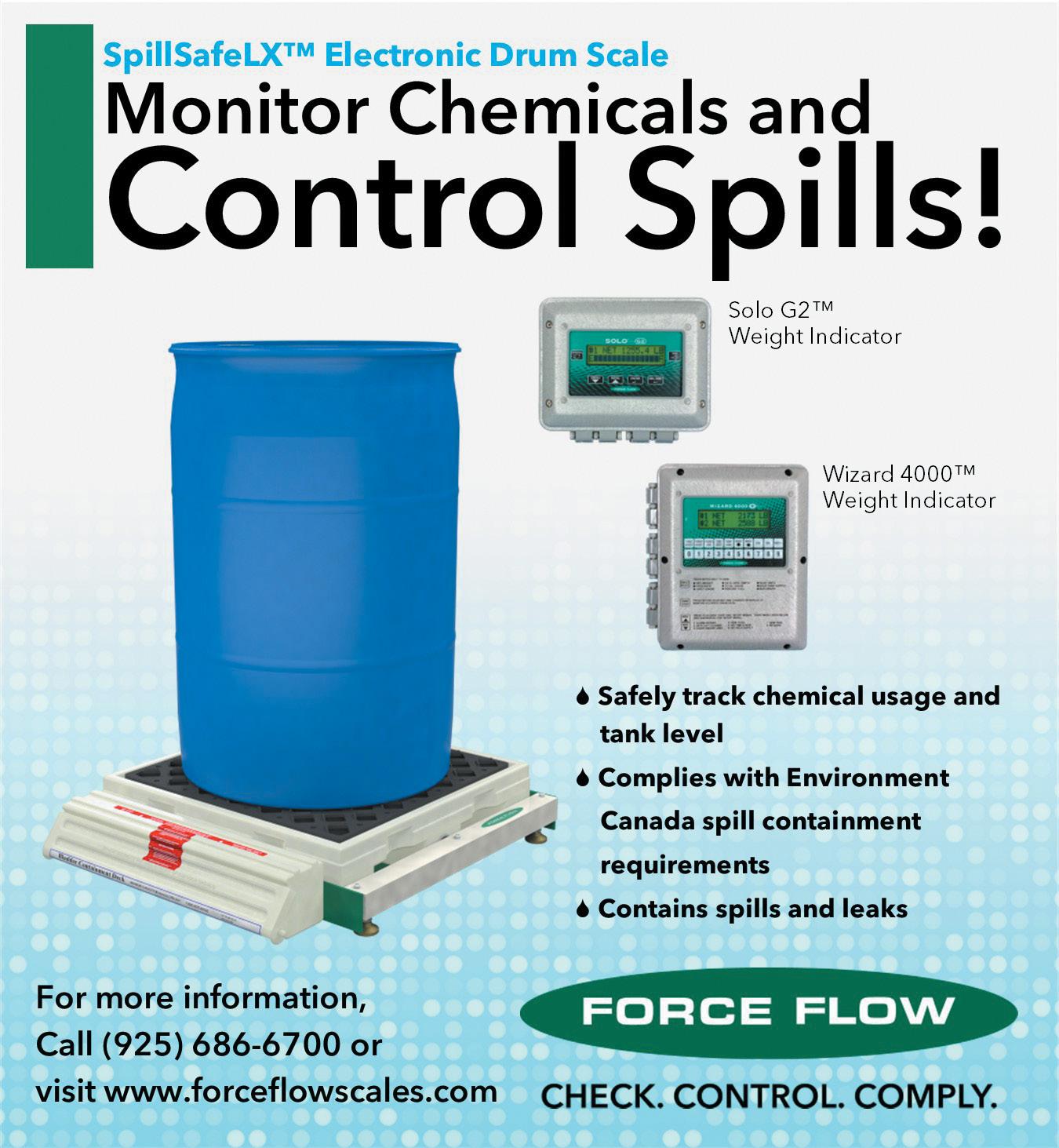
By Logan Peak
One critical component of effective wastewater treatment is the return activated sludge (RAS) pump. These pumps play a pivotal role in maintaining the fragile balance of biological activities within the treatment process.
In primary treatment, wastewater enters a primary clarifier or sedimentation tank. Here, the water is held so that larger, heavier solids can settle at the bottom, while oil, grease, and lighter solids rise to the surface. The settled material, known as primary sludge, is then removed from the tank using mechanical scrapers and pumps.
Sometimes, this primary sludge is transported out of the facility for further treatment and reuse in various applications. Primary treatment removes only about 60% of the suspended solids from wastewater. Consequently, secondary treatment is necessary to eliminate biological matter and soluble materials that need oxygen to decompose, along with any remaining suspended solids.
There are various methods for secondary treatment, with the activated sludge process being one of the most common.
Activated sludge is a mixture of microorganisms and suspended solids that metabolize and break down organic contaminants in wastewater. The process begins with wastewater and primary sludge in an aeration basin, where air is injected to help break down organic matter. Once this biological treatment occurs, the sludge is settled out in a secondary clarifier. A portion of this settled biomass, designated as return activated sludge, is then pumped back into the aeration basin to maintain a healthy and active microbial population.
Without this step, levels of settled sludge will continue to rise, eventually leading to overflow of the clarifier and a disruption in the treatment process.


Continuous flow is required to keep the microorganisms alive and maximize the efficiency of the process.
RAS pumps play a vital role in sustaining the microbial balance necessary for effective treatment. They are unique in that they must move large volumes of sludge with high solids content while minimizing shear forces that could damage the biological floc. This requirement places specific demands on their mechanical design.
Key features typically found in effective RAS pumps include large-passage impellers, often in a two-vane or recessed configuration. This allows the passage of fibrous and stringy materials without clogging.
The impellers are usually precision-cast and designed to reduce turbulence and maintain smooth flow, preserving floc integrity. Pumps with thick-walled volutes and smooth internal passages help reduce wear from abrasive materials, extending the service life of components. Pump reliability is further enhanced by the use of heavy-duty bearings and sealing systems designed for long service life under demanding conditions.
High-strength, corrosion-resistant shafts, often with renewable stainless-steel sleeves, are used to handle the mechanical stress of continuous operation while simplifying maintenance. Close-coupled vertical configurations are particularly advantageous in space-constrained treatment facilities, offering compact design and easier alignment.
Additionally, features like accessible packing boxes, clean-out ports, and externally adjustable impellers facilitate regular maintenance and minimize downtime.
Modern control strategies such as variable frequency drives (VFDs) are frequently employed to modulate flow rates, ensuring optimal return sludge flow while minimizing energy consumption. Remote monitoring promotes preventive maintenance and allows operators to fine-tune performance in real time and respond swiftly to changing influent characteristics.
These technical considerations are essential for maintaining stable biomass concentrations, avoiding upsets in biological treatment, and complying with
effluent quality standards.
Due to the requirement for continuous operation and often demanding conditions, redundancy and backup systems for RAS pumps are a necessity. Wastewater treatment plants cannot afford prolonged downtime, especially in the activated sludge process, where microbial stability is key. Designing systems with adequate redundancy ensures that maintenance or mechanical failure does not compromise effluent quality.
This is especially important in northern climates, where extreme weather can exacerbate equipment stress and complicate repair logistics. Proactive asset management and life-cycle planning are increasingly being adopted by municipalities to address these vulnerabilities and extend the operational lifespan of critical infrastructure.
Compounding the existing challenges are new and emerging contaminants that conventional secondary treatment methods may not adequately address.
Pharmaceuticals, microplastics, endocrine disruptors, and other trace pollutants are becoming increasingly prevalent in municipal waste streams.
While RAS pumps do not directly remove these substances, their role in maintaining stable and efficient biological treatment supports the broader functionality of advanced treatment processes, including tertiary filtration and disinfection. As regulatory standards evolve to address these emerging threats, the importance of foundational systems like RAS pumps will only grow.
Return activated sludge pumps may not be the most visible component of a wastewater treatment facility, but they are undoubtedly among the most critical. They play a crucial role in maintaining the delicate balance of biological processes.
Logan Peak is with Pentair, whose Canadian office is located in Cambridge, ON. For more information, email: orders.cacam@pentair.com

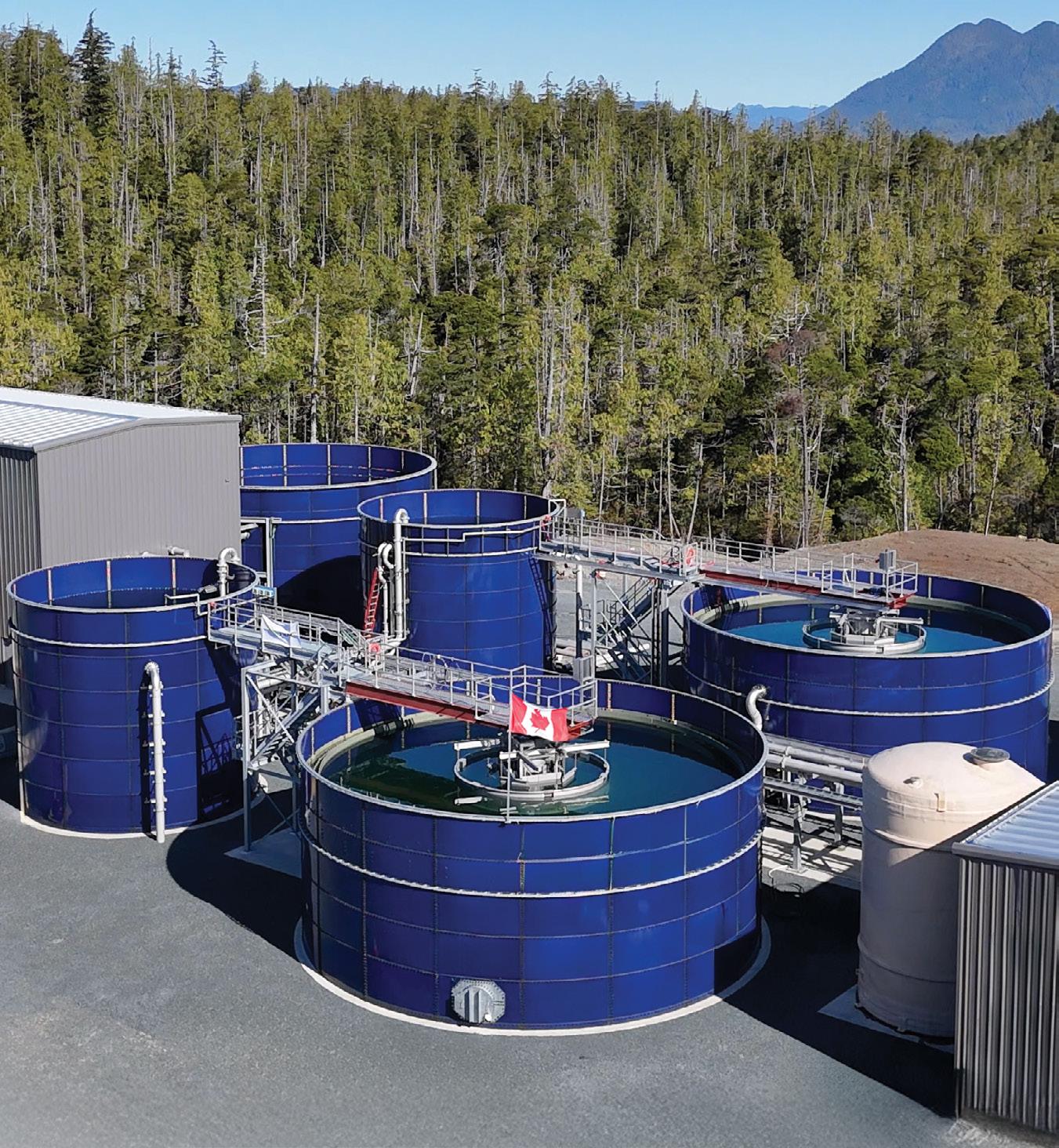


By Arnold Kleijn
Over the last couple of years, we have seen increased client interest in using mechanical vapour recompression (MVR) for evaporation. Given the turbulent rise and fall of energy markets since 2020 this is understandable, as the electrical energy employed in MVR is normally considerably cheaper than the thermal energy needed for traditional evaporation.
However, there are a number of limiting factors and key considerations when using MVR, particularly for very thick and viscous products like digestate and sludges. This can add to the capital cost (and complexity) of an MVR-based evaporation solution. It is therefore very important that all these elements are considered from the outset, so that an accurate investment decision based on both capital (Capex) and operational (Opex) costs can be made.
Traditional evaporation techniques use a high temperature service fluid
(such as pressurized steam) to raise the temperature of the product above its boiling point so that water (and other volatile compounds) is driven off, leaving a more concentrated solution. The principal source of energy for this process is therefore the fuel used to heat the water (steam) in the boiler, such as gas or oil.
In MVR, the steam which comes off the product in the evaporator is channeled into a compressor which increases the pressure (and therefore the temperature). This steam, which is now above the boiling point of the product, is then used as the service fluid for the evaporator. As the compressor uses an electric motor, the process is driven by electricity rather than thermal energy. Because the compressor reuses/recycles evaporated steam, a lot of latent heat is recovered. This makes MVR one of the cheapest methods of evaporating water in terms of operational costs.
However, because of the way MVR works, there are some inherent limita-
tions in the process which traditional thermal evaporation does not suffer from. When evaporating at atmospheric pressure, depending on the type of compressor, the temperature rise provided by the compressor is typically between 46°F and 59°F. The relatively small temperature difference between the service fluid and the boiling point of the product (~212°F) means that heat transfer between the two is limited and you need a large surface area to achieve it. To put it simply, you need a large heat exchanger.
In contrast, boilers can deliver maximum steam pressure of up to 116 or 145 psi, meaning an effective temperature of 320°F or 356°F. Even if general operation is below these levels, the fact is that steam from a boiler will be considerable hotter than from a compressor. The greater temperature difference means that less transfer surface area is required, and you can utilize a much smaller heat exchanger.
Because of the thick nature and high fouling potential of many digestates and sludges, often a relatively large sur-
face area is needed to achieve sufficient heat transfer. Because of the limitations of compressors in terms of service fluid temperature, the required heat exchangers and pumps can be exceptionally large indeed. Not only does this increase the capital cost significantly but, as larger pumps are needed to push the product through the larger heat exchanger, more energy is required for operation. As such, the operational cost benefits begin to reduce.
Digestate and sludges often contain suspended solids, which increase the viscosity of the product when evaporated, adding further to the challenges described above. Therefore, if you want to use MVR evaporation, you will need to pre-treat the product to remove as many of these solids as possible. This is usually done with filtration, in order to achieve the necessary rates of heat transfer in the heat exchanger. Again, adding this pre-treatment step adds significant capital costs and reduces potential energy savings during operation.
Digestate also typically contains between 2,000 ppm and 3,000 ppm of ammonia. Pre-treating the product with acid to reduce the pH can neutralize the ammonia, preventing it from evaporating and reducing the risk of damage to the compressor. But, this means acid dosing, which adds additional cost and operational complexity. You also need to consider the nature of the material and the necessary combination of chemical and physical pre-treatment.
Evaporating digestate and sludges using MVR is certainly possible and HRS Heat Exchangers have supplied such systems where they are appropriate. However, our experience has shown that careful consideration, including the system modifications which may be required to ensure efficient and effective evaporation of the project, is essential in order to determine the most suitable and most economical technology for each project.
For example, do the high capital costs of an MVR-powered evaporation solution outweigh the reduced operational
costs? For many digestate applications, traditional thermal-based evaporation technologies remain the best economic choice, but every situation must be assessed on its own merits.
It is important that the nature of the product is thoroughly assessed and understood, and that all the necessary parts of a complete system are specified and included from the outset, so that








an accurate investment decision based on all the necessary information can be made. Otherwise, you could end up with an expensive solution which does not perform as expected.
Arnold Kleijn is with HRS Heat Exchangers. Email: info@us.hrs-he.com






















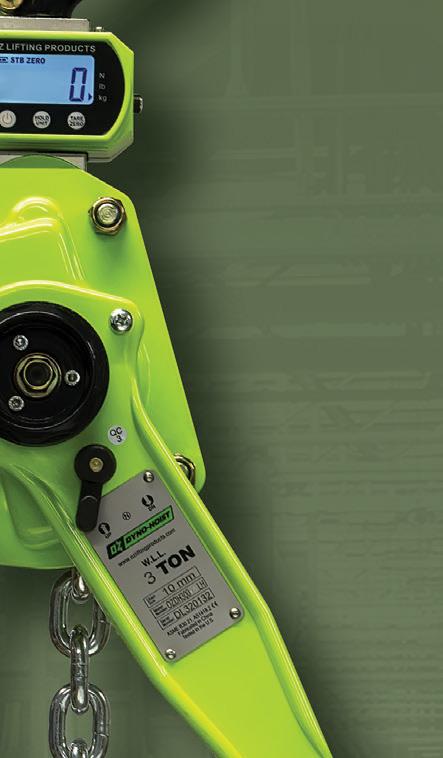









By ES&E Staff
Arecent provincial audit has raised concerns about the oversight of non-municipal drinking water systems in Ontario, revealing gaps in inspections, enforcement, and testing that could pose health risks to millions of residents.
While more than 98% of samples tested from non-municipal drinking water systems over the past decade have met Ontario standards, the audit report has a series of recommendations for small drinking water systems and private wells where testing may be infrequent and not part of that 98%.
The audit report contains 17 recommendations from the Office of the Auditor General of Ontario, which highlights that the Ministry of the Environment, Conservation and Parks (MECP) lacks capacity to regularly inspect all 1,816 non-municipal systems in the province that serve some three million Ontario residents, mostly in rural and remote areas.
By the end of the 2023-24 inspection cycle, about 34% of non-municipal water systems have not been inspected in five years or more, and 9% have not been inspected for more than seven years, the audit found.
“A lack of testing can expose Ontarians to risks,” says Ontario Auditor General Shelley Spence in a special report tabled in the Legislature. When it comes to small drinking water systems, such as a hotel, restaurant or church, the audit found that public health units did not have effective means to inspect systems that have not properly self-reported.
Public health units are required to inspect low to moderate risk systems at least once every four years, and high-risk systems at least once every two years. However, the audit found that 52% of the 33 health units that have small drinking water systems in their region, didn’t inspect all systems as required, with some units noting inspection backlogs dating back more than five years. Twelve of the health units noted inspection backlogs attributed to staffing and resource challenges.
More than half (932) of the drinking water systems regulated by local health units had missed at least one sample in the last five years, the audit found. Additionally, 20% of those had missed an entire year of samples and 5% had missed multiple years. Of the 932 non-compliant systems, health units issued fines to only 11 of them.
“A lack of enforcement of water testing could lead to risks for water safety,” states the audit report. Almost all local health units told the audit staff that they had issues with the national certification process for assessing small drinking water systems, noting that the inspection staff felt inadequately prepared to assess risks.

An audit report found that 34% of smaller systems regulated by MECP had not been inspected in more than five years. Credit: Quality Stock Arts, stock.adobe.com
Over the past five years, 20 local health units have also found approximately 260 unregistered small drinking water systems that did not notify officials of their existence before starting operation of their systems, the report states.
Spence’s audit report recommends that public health units work with the Ministry of Health to assess the extent of and reasons for inspection backlogs, including resources and costs. Additionally, Spence’s team recommends the development of strategies to ensure that local health units can deliver on responsibilities to inspect small drinking water systems at the required frequency.
The report also addresses what it calls a lack of guidance from the Ministry of Health regarding short-term rentals booked through online platforms and whether they are to be considered public facilities regulated by local health units. “Because of this, visitors to short-term rentals may drink or cook with water from an unregulated water supply that may or may not have been tested by the owner, thus creating a potential health risk,” states the report.
Notably, the audit report also found that 34% of systems regulated by MECP had not been inspected in more than five years. After MECP expanded the workloads of its compliance officers to include additional responsibilities, such as inspecting municipal sewage and stormwater systems, the number of inspections declined 45% between 2012 and 2020.
For more information, email: editor@esemag.com
By ES&E Staff
Officials in Tucson, Arizona, have struck a federal grant deal to receive $86.7 million towards building a treatment plant able to purify wastewater, as long as the city can reduce its reliance on water from the strained Colorado River.
The plant, set for completion in 2031, would see utility Tucson Water take a portion of what is now being discharged into the river and purify it to supplement the drinking water system with about 9.5 million litres per day.
The grant from the Bureau of Reclamation hinges on the city reducing its water use from the Colorado River to achieve a reduction of 56,000 acre-feet of water by 2035.
Arizona cities and water providers can now apply for a permit to use advanced water purification.
Like California, Arizona has been quick to develop a legislative framework for wastewater reuse. The Arizona Department of Environmental Quality (ADEQ) issued the draft rules last year and finalized a regulatory framework in April 2025. Arizona cities and water providers can now apply for a permit to use advanced water purification.
The new plant is rooted in Tucson’s One Water 2100 plan, an approach that “treats all water resources as equally important, including surface water, groundwater, recycled water, and rain

A multi-step barrier system is used to remove pathogens and organics in the water, followed by the removal of chemicals and byproducts from the water; then a reduction of water salinity to create purified water. Graphic: Tucson Water
and stormwater harvesting.”
As a state, Arizona has a long history of putting treated wastewater to beneficial use, particularly for agriculture. Scottsdale was the first to build a pilot program for advanced water purification at its advanced water treatment facility. Phoenix is working on rehabilitating the Cave Creek Water Reclamation plant, which will treat 30 million litres of wastewater per day. Phoenix officials also want to build a regional Advanced Water Purification facility at its 91st Avenue Wastewater Treatment Plant. For more information, email: editor@esemag.com
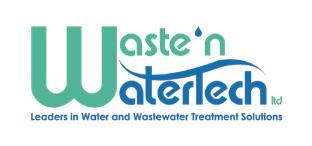

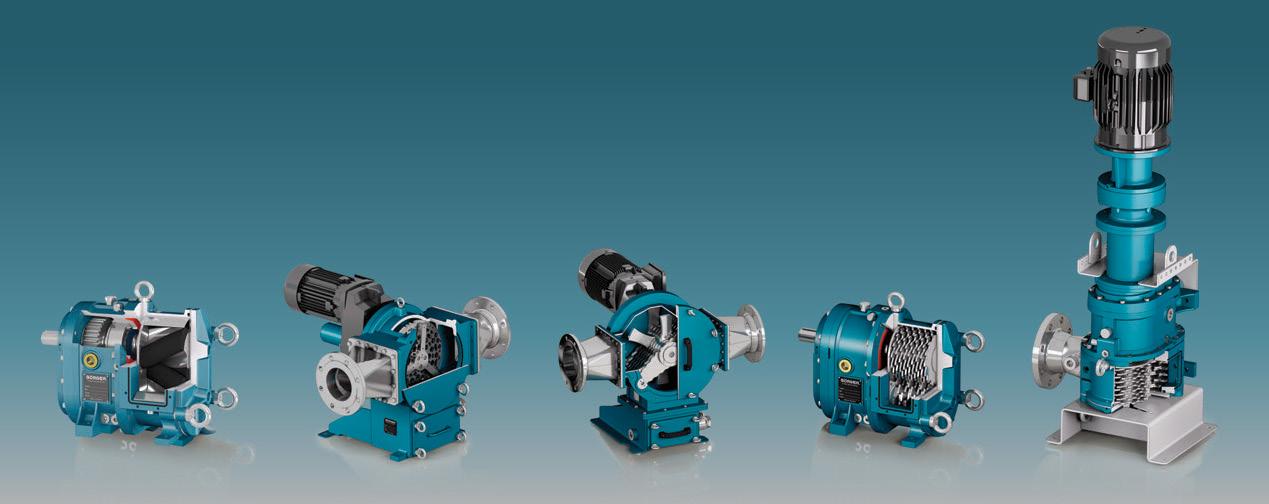
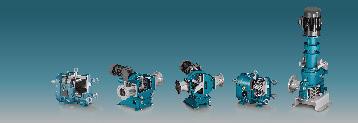


By ES&E Staff


Anew pilot project in the U.K is using wastewater biogas to produce hydrogen and carbon, capturing the carbon in solid form as graphene, one of the strongest materials on the planet. Graphene, a two-dimensional form of carbon, has a single layer of carbon atoms arranged in a honeycomb lattice. Once split from CH4, it can be used to extend the life of vehicle tires, enhance cement, boost the performance of batteries and solar panels, or create cut-resistant fibres.
Biogas from primary digestion of sewage sludge averages in the region of 60% to 65% methane. British climate tech firm Levidian is leading the project at United Utilities’ largest wastewater treatment complex in Manchester. Its LOOP system uses electromagnetic waves to split the methane gas (CH4).
The lower carbon blend gas is then fed into an on-site generator where it is burned to help power the Manchester Bioresources Centre. It is part of the Davyhulme Wastewater Treatment Works, one of the largest in Europe, and widely considered to be the birthplace of the activated sludge process in 1914.
“This trial is a world first,” said Tom Lissett, bioresource and green energy director at United Utilities, in a statement. “We already use sewage sludge as a sustainable feedstock for renewable energy and biomethane production and this project brings potential to really build on that,” Lissett added. Levidian estimates that biogas generated from sewage could produce up to 75,000 tonnes of hydrogen a year, enough to fuel over 40% of all U.K. bus and coach trips.

a two-dimensional form of carbon, has a single layer of carbon atoms arranged in a honeycomb lattice. Credit: AlexanderAlUS, CC BY-SA 3.0, Wikimedia Commons
“Hydrogen is set to play a critical role in meeting the U.K.’s legally-binding commitment to achieve net zero by 2050, but is currently being held back due to the cost of production, This is an issue we hope to unlock here in Manchester as we continue to scale our LOOP technology to industrial levels,” announced Levidian CEO John Hartley in a statement.
According to the International Energy Agency (IEA), wastewater biogas remains one of the most underutilized sources of renewable energy globally.
For more information, email: editor@esemag.com
By ES&E Staff
The City of Brantford, Ontario, has been running four new reverse osmosis (RO) mobile unit trailers at its water treatment plant as a pilot project to combat elevated nitrate levels in the Grand River.
While naturally present in soil, water, air and plants, nitrate increases in the city’s water supply are largely attributed to upstream agricultural runoff, livestock operations, and wastewater treatment facilities that discharge into the Grand River or its tributaries. Levels can spike in the winter and early spring months, although never exceeding the maximum acceptable concentration (MAC) of 10 mg/L (measured as nitrate-nitrogen), local officials said.
Provided by Veolia Water Technologies, the new RO units ran until May. Now, the city can evaluate their effectiveness since implementing the units in February. Typically, the units ran for a couple of days following heavy rain to lower nitrate levels.
“Implementing a system of this scale typically takes up to five months,” announced Selvi Kongara, City of Brantford Director of Environmental Services, in a statement. “Thanks to the dedicated, aroundthe-clock efforts of water operations staff, we fast-tracked the commissioning and installation process in just six weeks. We are seeing positive results, with the units effectively reducing nitrate levels in the City’s drinking water.”
Brantford officials added that the reverse osmosis units will serve as an important short-term mitigation measure, while the city continues to explore and advance long-term solutions, including groundwater blending and broader upgrades to water treatment infrastructure.
For more information, email: editor@esemag.com


By Ellen Campbell
Located in Ontario’s Kawartha Lakes region, Peterborough is a city deeply connected to water, from its historic hydroelectric legacy to its ongoing efforts in stormwater management and climate adaptation.
As Jackson Creek flows into Little Lake, key sites for recreation and community life, both face increasing environmental challenges like erosion, pollution, and harmful algae blooms, threatening water quality, ecosystems, and public access.
To help address this problem, the city partnered with Rain It In, a Canadian non-profit that challenges post-secondary students to develop climate resilient solutions that have a focus on flooding.
Thirty students from 10 academic programs across Canada stepped up to answer the question: How can the City of Peterborough improve the health of Jackson Creek and Little Lake through restoration, public access, and policy? It was inspiring to see participation from institutions across Canada, including Seneca Polytechnic, the University of Alberta, York University, the University of Toronto, and the University of New Brunswick.
Cash prizes were awarded to the top three teams. However, the true value lay in the hands-on experience of tackling a real-world water issue alongside a supportive network of professionals. Participation from institutions, including Seneca Polytechnic, the University of Alberta, York University, the University of Toronto, and the University of New Brunswick made this collaborative effort even more inspiring.
Participants engaged in a series of development opportunities, including:
• An informational webinar to kickstart project research,
• A mentorship workshop, in partnership with the Ontario Water Works Association, where industry experts shared advice and career insights,
• A skills development workshop to

help students master the art of the pitch. This workshop not only prepared them for the final phase of the competition, where they pitched their solutions, but also equips them with a crucial skill that will benefit them throughout their personal and professional lives — whether in job interviews, networking events, or presenting ideas in work or volunteer settings.
Each team submitted a report and pitch video, with the top five invited to present their recording and answer questions from a panel of judges from within the water sector.
“It was a privilege to witness the next generation of leaders tackle real-world water challenges with such passion,” said Curtis Mei, stormwater systems specialist with the City of Peterborough. “The ideas presented throughout the competition have given us renewed hope and fresh perspectives on how we can work
together to protect our water resources for generations to come.”
First place went to Seneca Polytechnic sustainable urban and transportation planning students Jose Bernardo Gochoco III, Ashish Acharya, Shivani Bharatkumar Dave, Emerson Pardoe and Alyssa Rae Tejada. The team presented a nature-based solution that integrates riparian restoration and floating treatment wetlands to not only improve water quality, but to also enhance biodiversity while fostering community engagement.
Second place went to University of Alberta agricultural and resource economics students BM Sadikullah Mahmud, Laura Isaacs, Dipa Sultana and Hridoy Gope. The team proposed a tailored set of practical, cost-effective strategies, including rain gardens, permeable pavements, shoreline restoration, and community engagement, designed to
meet Peterborough’s unique environmental needs, community values, and fiscal constraints.
Third place went to York University BSc computer science students Prabhkrit Singh, Parmeet Singh and Mohammad Areeb. The team pitched the use of bioswales to reduce flooding, erosion, and pollution through green infrastructure, while promoting policy updates, community engagement, and long-term environmental resilience.
Rain It In would like to pay special thanks to the judging panel:
• Curtis Mei, stormwater systems spe-


•Sustainable Water Solutions
•Site Assessment, Remediation and Closure
•Air Quality and Emissions Services
•Environmental Planning and Natural Resources
•Digital Services
By Eric Meliton
While often discussed interchangeably, reducing greenhouse gas (GHG) emissions and removing carbon dioxide from the atmosphere (CDR) are distinct processes. Emissions reduction focuses on preventing GHGs from entering the atmosphere. CDR methods aim to extract and permanently sequester existing atmospheric carbon dioxide, often leveraging natural processes like photosynthesis.
Biochar production involves pyrolyzing organic waste in a low-oxygen environment, stabilizing carbon that would otherwise decompose and release methane, so it can contribute to both processes. It converts plant matter into a stable product, providing a sustainable pathway for carbon removal and sequestration, while at the same time helping to prevent the release of methane that would have otherwise been produced by the plant matter decomposing in a landfill.
Industries, such as agriculture, mining, and construction, are finding innovative ways to integrate biochar into their operations, lowering cost, improving performance and/or further driving down their carbon footprints. In agriculture, biochar enhances soil health and fertility while suppressing nitrous oxide emissions. In mining, biochar helps stabilize tailings, preventing the release of heavy metals and acidic runoff while mitigating emissions associated with traditional remediation processes. Even the construction sector is exploring biochar-infused concrete to lower the embodied carbon of building materials, offering a more sustainable alternative to conventional aggregates.
Recently, biochar has gained recognition for its potential in wastewater

Biochar can be produced from a wide range of organic feedstocks, offering a low-cost and resource-efficient alternative with a built-in waste diversion benefit.
treatment and landfill leachate filtration. Its highly porous structure and chemical properties enable the removal of key contaminants, including ammonia, phosphorus, biological oxygen demand (BOD), chemical oxygen demand (COD), and persistent organic pollutants such as PFAS and pharmaceutical residues.
Composed of a complex mixture of organic and inorganic contaminants that threaten soil and water resources, landfill leachate represents a significant environmental hazard. Conventional treatment methods, including chemical precipitation, membrane filtration, and biological treatments, can be costly and energy intensive.
Biochar’s effectiveness as a filtration medium is directly linked to its distinct physical and chemical properties, which can be tailored to target specific contaminants found in landfill leachate and agricultural runoff. One of its major characteristics is its alkalinity. This makes it particularly effective for treating acidic effluents, as it promotes neutralization and facilitates the precipitation of heavy metals and other pollutants. The high pH also contributes to the removal of
ammonia (NH₄+).
Biochar’s porous structure is also a significant factor in its filtration efficiency. Its porous variety (micropores, mesopores, and macropores) provides a large surface area for adsorption, to trap contaminants. As well, its particle size can be optimized to control flow rates and maximize contaminant contact, making it a highly adaptable solution for wastewater treatment applications. Biochar also maintains a high cation exchange capacity, which enhances its ability to capture dissolved metals, nutrients, and organic pollutants.
Biochar presents a viable cost-saving alternative to traditional filtration media, such as steam-activated charcoal and activated carbon for wastewater treatment. While activated carbon remains a widely used adsorbent, due to its high surface area and contaminant removal effectiveness, biochar can provide advantages that enhance both environmental and economic feasibility in large-scale treatment applications.
The most significant benefits of biochar lie in its lower production cost and reduced carbon footprint to generate. It is inherently carbon-negative, offering a dual benefit of wastewater treatment and carbon sequestration.
Excess phosphorus from agricultural runoff and municipal wastewater treatment plants contributes to harmful algal blooms and eutrophication in freshwater systems. Biochar, particularly when engineered with metal oxides, has demonstrated significant phosphorus adsorption capacity. Its alkaline nature facilitates phosphorus precipitation, preventing nutrient overloading in aquatic environments.
Once biochar reaches saturation in filtration systems, it retains value through secondary applications, which enhances overall circularity. Contaminant-laden biochar can be repurposed as an additive in construction materials such as concrete, asphalt, or bricks, effectively locking in heavy metals and other pollutants, while reducing the environmental



impact of traditional building materials. Phosphorus-laden biochar can also be repurposed as a soil amendment, as it becomes a medium for slow-release of nutrients. In some cases, biochar can also be regenerated and reused in filtration systems, further extending its overall utility.
Biochar presents a scalable alternative to activated carbon and ion exchange resins to address PFAS, particularly when optimized through hydrophobic interactions and electrostatic attraction.
Biochar also shows potential in filtering pharmaceutical residues and dyes, which are increasingly detected in wastewater effluents. Its adsorption capabilities, combined with the potential for microbial degradation in biochar-enhanced treatment systems, make it an attractive option for effective mitigation of emerging pharmaceutical contaminants.





As industries and governments intensify their focus on climate resilience and sustainable waste management, biochar is emerging as a commercially viable and scalable solution. Unlike other carbon-based adsorbents that require energy-intensive processing, biochar can be produced from a wide range of organic feedstocks, offering a low-cost and resource-efficient alternative with a built-in waste diversion benefit.
Biochar’s commercial potential extends to carbon credit markets. Companies committed to net-zero targets are actively seeking verifiable CDR solutions. The carbon-negative nature of biochar production aligns with the evolving standards of voluntary carbon markets and corporate sustainability programs. Organizations such as Frontier Climate, Shopify, and Microsoft are already investing in high-integrity CDR solutions, signaling a growing demand for biochar’s climate continued overleaf…

















































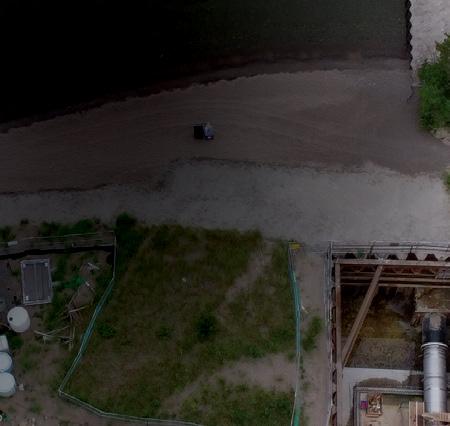


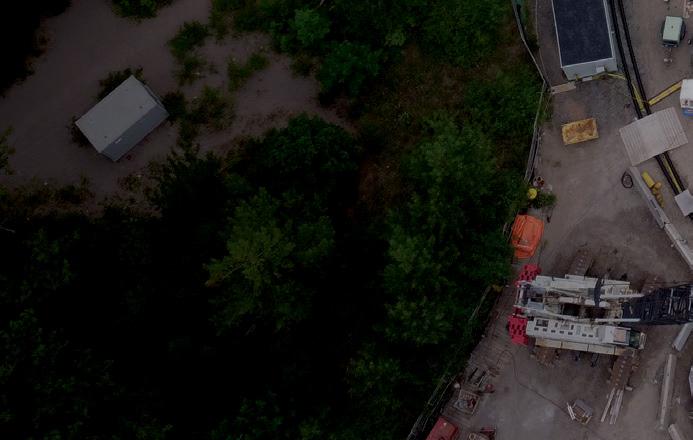






mitigation potential globally. Additionally, governmental shifts toward sustainable waste-to-value strategies may further incentivize biochar adoption through subsidies, tax credits, and policy-driven procurement programs.
Despite its overall promise, widespread biochar adoption faces scalability and commercialization challenges. Production consistency, feedstock availability, and process optimization remain key considerations. Ensuring that biochar meets industry-specific filtration requirements will be crucial for broader industry integration.
Additionally, while biochar is generally cost-competitive with activated carbon, initial infrastructure investments and regulatory approvals can create barriers to entry. Collaborative validation efforts among government agencies, research institutions, and industry stakeholders are essential to overcoming these hurdles to overall market viability.
To further incentivize industry participation, the Sustainable Finance Action
Council has provided recommendations on removing barriers to increase private capital flow into net-zero and resilience solutions, including enhancing financial mechanisms that support investments in technologies like biochar production. This aligns with the growing demand for CDR solutions and offers industries the potential to access carbon credit markets, further enhancing biochar’s economic viability.
Public policy is pivotal in advancing biochar’s role as a CDR solution for wastewater treatment. Federal and provincial governments could implement incentive structures (such as carbon credits and subsidies) to encourage investment in CDR solutions. Programs such as Canada’s Clean Growth Program and international carbon credit markets present opportunities for biochar producers to monetize carbon sequestration.
Additionally, Canada’s Carbon Management Strategy outlines a vision for a
robust carbon management sector that supports sustainable economic growth and high-value employment. This strategy emphasizes technology-enabled carbon management solutions, which would include biochar production to reduce, remove, and reuse CO2 emissions.
These policies and initiatives at all government levels underscore Canada’s commitment to fostering a conducive environment for biochar and other CDR solutions, promoting overall scalability and commercial viability.
Canadian regulatory frameworks must also evolve to support biochar’s classification as a validated CDR technology. Establishing clear standards for biochar quality and application guidelines will provide industry confidence in its longterm viability. This will positively trickle down into provincial and municipal regulations, pushing for acceptance as markets evolve over time.
Eric Meliton is with Echion Group. Email: eric.meliton@echiongroup.net


internal structure.
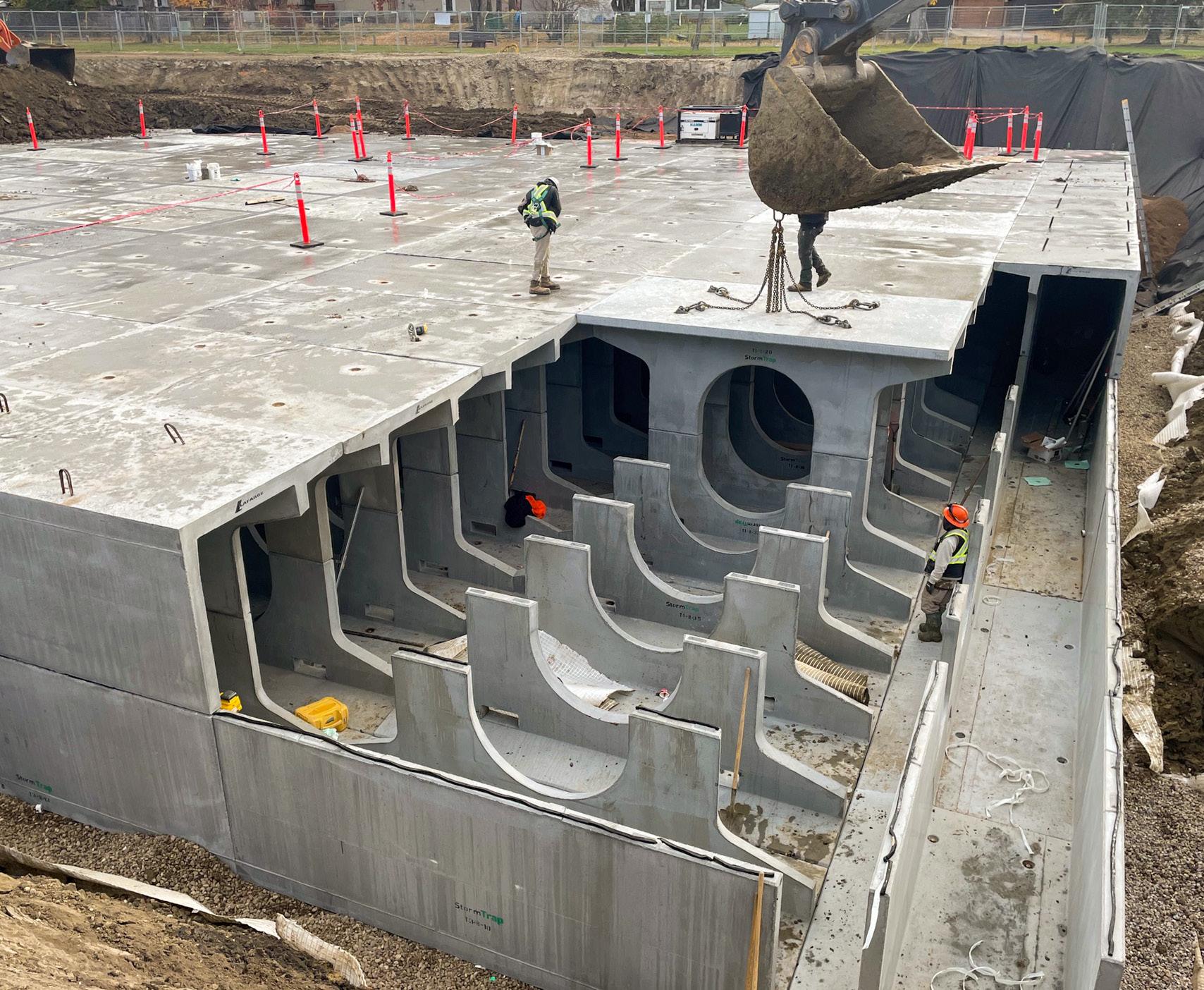
By Hassan Rauf
Flooding has historically been a significant challenge in Brevoort Park South, a neighborhood in Saskatoon, Saskatchewan, frequently affected by flood events, with future risks amplified because of climate change. Areas developed before 1989 are particularly vulnerable, due to the absence of modern stormwater systems, unlike newer developments.
An innovative approach was chosen to solve the challenge of stormwater storage without loss of land, enabling preservation of the local landscape and environment. Instead of the more traditional dry pond approach, the project utilizes underground modular precast storage tanks.
With a capacity of 8,600 cubic metres, the underground storage system is designed to collect and store stormwa-
ter during heavy rainfalls. This collected water is then released in a controlled manner to alleviate excessive strain on the existing storm sewers to mitigate the risk of flooding.
The underground storage system features a total of 561 modular precast units. These were produced at the Lafarge Precast Plant in Winnipeg in only 71 days — an impressive production rate of eight units per day. This high level of efficiency was complemented by zero recasts required, reflecting Lafarge’s strong commitment to quality assurance and precision in manufacturing.
The installation of these underground tanks began on September 10, 2024, and was completed by October 24, 2024. Over this six-week period, 561 units were installed, with crews averaging between 20 to 24 units each working day.
The total cost of this project stands at $10.3 million, with funding sourced from both the city and the Government of Canada. The city covered 60% of the costs ($6.2 million), while the federal government provided the remaining 40% ($4.1 million). This collaborative effort underscores the importance of multi-level government and private sector partnerships in addressing infrastructure challenges.
This project represents a significant leap forward in flood risk management for Brevoort Park South. By leveraging an innovative precast solution and a collaborative approach to funding and execution, the project has successfully mitigated a long-standing issue that has plagued the community. The restored recreational field, the minimized environmental impact, and the enhanced resilience against future flood events all stand as testament to the project’s success.
As climate change continues to pose challenges for urban areas, innovative projects like this one set a precedent for how cities can proactively safeguard their communities. Brevoort Park South now stands more prepared and resilient, thanks to this transformative initiative.
Hassan Rauf is with Lafarge Canada Inc. Email: hassan.rauf@lafarge.com

By ES&E Staff
Stantec is set to design the highest capacity PFAS removal system in the northwestern U.S. for a high-volume water station in Vancouver, Washington.
Stantec will also provide engineering services during construction of the treatment facility at Vancouver’s Water Station 4, one of the first stations in Vancouver’s water supply that will treat water for per- and polyfluoroalkyl substances (PFAS). When complete, the PFAS filter system will treat up to 46 million litres per day.
Stantec’s design will integrate the treatment system into the Water Station 4 site while keeping it functional and maintaining water supply for the city during construction. Treatment facility construction is expected to begin this October and be completed in early 2028, over three years ahead of the EPA’s newly proposed compliance deadline for public water systems.
In 2024, the U.S. Environmental Protection Agency (EPA) issued a requirement for all public water utilities in the U.S. to reduce PFAS in drinking water by 2029. Following one year of consultation to determine enforceable maximum contaminant
levels for PFAS, the EPA ultimately maintained its proposal of 4 parts per trillion, or nanograms per litre, for perfluorooctanoic acid (PFOA) and perfluorooctane sulfonic acid (PFOS), the lowest concentration most laboratories can reliably detect.
In accordance, cities and municipalities around the U.S. are exploring proper treatment systems to address PFAS in their water supply. The EPA will also require public water systems to begin reporting on PFAS levels in 2027.
According to industry research, PFAS treatment is estimated to require approximately $40 billion in capital investments by water utilities.
On average, the City of Vancouver delivers 38 billion litres per year of drinking water to more than 270,000 people. In 2023, city officials started a program to test for and report PFAS in drinking water, discovering that upgrades were necessary to properly treat and reduce PFAS contaminants to meet anticipated state and federal regulations.
For more information, email: editor@esemag.com
Researchers at the University of Waterloo are playing a key role in Canada’s push to reduce methane emissions from landfills and oil and gas by using advanced imaging technology.
Among other instruments, an interdisciplinary team from Waterloo’s faculties of Science, Environment, Mathematics and Engineering, is utilizing a hyperspectral camera, also known as a “Hyper-Cam,” to track methane emissions at the Region of Waterloo’s Erb Street landfill.
Developed by Quebec City-based Telops, the Hyper-Cam can capture hundreds of images at different wavelengths, allowing researchers to pinpoint hotspots for methane, a greenhouse gas

80 times more potent than carbon dioxide over a 20-year period.
Dr. Kyle Daun, a professor in the Department of Mechanical and Mechatronics Engineering, who leads the project, says that landfills account for 20% of Canada’s methane emissions, and most of that comes from hotspots. Once hotspots are identified, the team can recommend measures to reduce emissions, such as covering or sealing problem areas.
Reducing methane is considered one
of the fastest ways to slow global warming and will continue Canada’s progress toward meeting the country’s 2050 netzero target.
At the same time, a team of researchers led by Dr. Laura Hug in the Department of Biology, studies the microbes living in the landfill’s soil and the impact of the hotspots on those organisms, the researchers announced in a statement. The research could help determine which microbes naturally limit methane release and how they could be harnessed to reduce emissions at other sites. “We are seeing what microbes are present in the cover soil and how they are responding to the increase in methane or change in environment,” Hug stated.
Beyond landfills, the Waterloo group is also collaborating with Telops on airborne methane detection, using helicopter-mounted Hyper-Cams to survey oil and gas sites in Western Canada. The data helps operators locate and repair leaks and assists regulators in enforcing environmental laws.

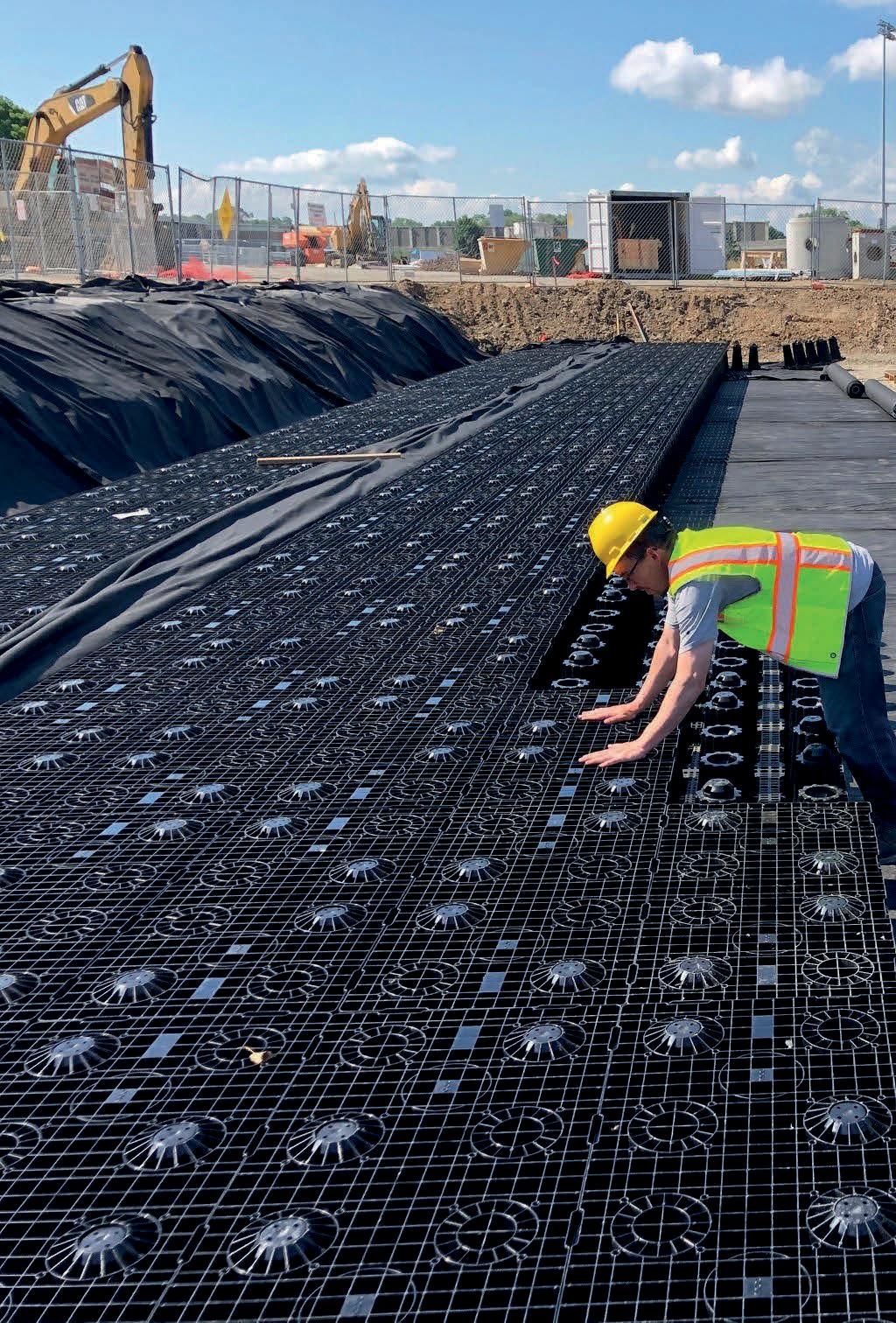




The AquaPrime® cloth media filtration system is designed as an economical and efficient solution for the treatment of primary wastewater and wet weather applications with high quality effluent, even under varying influent conditions. This system utilizes a disk configuration and the exclusive OptiFiber PF-14® pile cloth filtration media to effectively filter high solids waste streams without the use of chemicals.
Represented by ACG-Envirocan T: 905-856-1414
E: sales@acg-envirocan.ca
W: www.acg-envirocan.ca
Aqua-Aerobic Systems, Inc.
T: 815-654-2501
E: solutions@aqua-aerobic.com
W: www.aqua-aerobic.com

The Aqua MegaDisk® tertiary filter “expands” on the reliability and exceptional performance of the original AquaDisk® filter, but on a larger scale. The Aqua MegaDisk offers larger diameter disks and fewer mechanical components than the AquaDisk filter. The result is the smallest footprint available, operating in 80% less space than sand filters with comparable hydraulic capacity.
Represented by ACG-Envirocan
T: 905-856-1414
E: sales@acg-envirocan.ca
W: www.acg-envirocan.ca
Aqua-Aerobic Systems, Inc.
T: 815-654-2501
E: solutions@aqua-aerobic.com
W: www.aqua-aerobic.com

Asahi/America’s Series 19 electric actuators offer multi-voltage capability, visual position indicators, LED lights, auxiliary contacts, and QR codes for user manuals. With a corrosion-resistant NEMA 4X resin enclosure and stainless steel trim, they protect the brushless DC motor and steel gear train. Available in various configurations, ensuring reliable, precise control.
Asahi/America
T: 800-343-3618
F: 800-787-6861
E: asahi@asahi-america.com
W: www.asahi-america.com

Need a solution for your site? BARR Plastics offers reliable stormwater management solutions that help you meet regulations and protect your site. Our systems support infiltration, detention, and retention while saving space and reducing flooding risks. Ideal for residential, commercial and municipal projects. Explore underground and aboveground options backed by expert support.
BARR Plastics Inc.
T: 1.800.665.4499
E: info@barrplastics.com
W: www.barrplastics.com
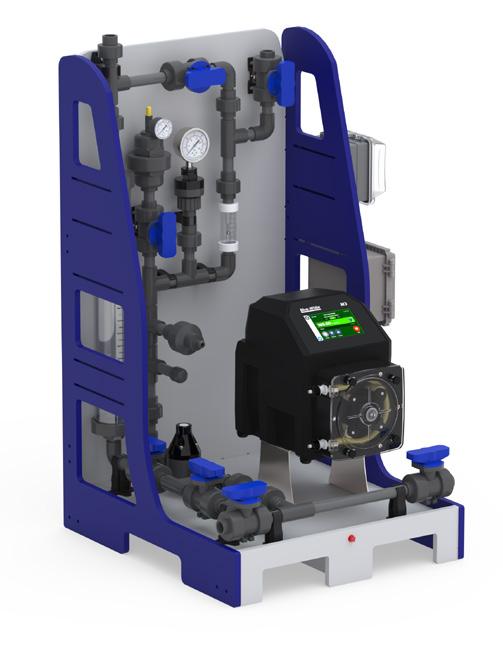
The CHEM-FEED engineered skid system is ideal for small spaces with a condensed design. The skid is constructed of strong and lightweight chemical and UV-resistant polyethylene. It is shipped fully assembled and features leak-free threadless connections and built-in fluid containment tray. Available in one and two pump configurations.
Blue-White Industries
T: 714-893-8529
E: info@blue-white.com
W: www.blue-white.com

CHEM-FEED MD3 technology will help mitigate problems and ensure smooth, accurate, and dependable chemical dosing. The MD3 is equipped with our exclusive Dual Diaphragm Hyperdrive Technology for smooth, near continuous feed, like a peristaltic pump, but with no tube to change. It is outfitted with DiaFlex® Diaphragms, which are designed to last the life of the pump.
Blue-White Industries
T: 714-893-8529
E: info@blue-white.com
W: www.blue-white.com

Introducing the OrbitGrinder, a compact, powerful cutting basket macerator with our Constant Cutting System for consistent maceration results. Customizable components and adjustable perforations allow tailored performance. Designed for Maintenance In Place (MIP®) and energy efficiency, the OrbitGrinder ensures optimal solids management, reducing downtime and operational costs. Ideal for any operation requiring precise maceration.
Boerger, LLC
T: 612-435-7300
E: america@boerger.com
W: www.boerger.com
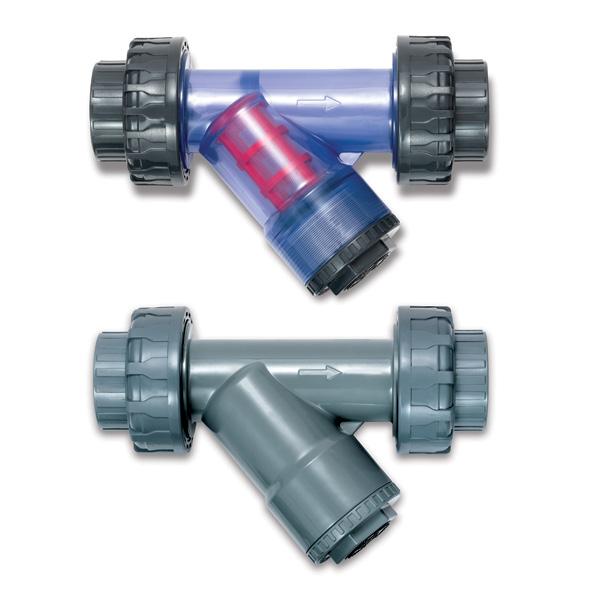
Chemline’s YD Series True Union Y Sediment Strainers are safety filtration devices designed to entrap occasional solid impurities. This protects equipment with small orifices and prevents damage to pumps or control valves. With a large filtering area, more sediment can be trapped. Available in clear PVC or opaque CPVC, with replaceable filter screens in a choice of meshes in polypropylene or stainless steel.
Chemline Plastics
T: 800-930-CHEM (2436)
F: 905-889-8553
E: request@chemline.com
W: www.chemline.com

The WEMCO® Hydrogritter from Trillium Flow Technologies is a durable grit cyclone and classifier with a lifespan exceeding 25 years. Its system-designed components ensure long-term, high-performance grit removal, offering unmatched reliability and low operation and maintenance costs. The WEMCO Hydrogritter system removes and dewaters grit from primary sludge or influent.
Directrik Inc.
T: 905-565-9606
E: sales@directrik.com
W: www.directrik.com or www.trilliumflow.com

The Chlor-Scale 150™ from Force Flow provides a simple and reliable way to monitor the amount of chlorine or ammonia used, and the amount remaining in the cylinder. The solid PVC scale platform, with a 5-year warranty, provides the strongest defence against the corrosive environments associated with gas feed applications. Electronic and hydraulic options.
Force Flow
T: 800-893-6723
W: www.forceflowscales.com
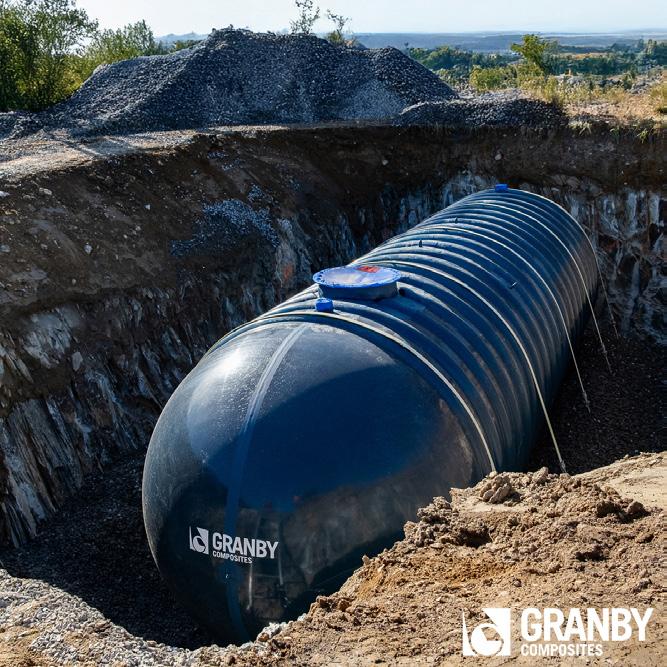
Granby Composites manufactures premium fiberglass tanks with customizable designs and expert engineering. Our lightweight, corrosion-resistant tanks range from 2,000–42,000 gallons and 6–10 feet in diameter. Built for reliability and easy installation, our solutions ensure durability and performance for all your drinking water and wastewater storage needs.
Granby Composites
T: 819-344-2525
E: info.gc@granbyindustries.com
W: www.granbycomposites.com

HydroMix is a low-maintenance hydraulic mixing system designed to reduce energy use and operating costs. With no moving parts inside the tank, it minimizes wear and downtime while maximizing mixing efficiency. Ideal for wastewater and biogas applications, HydroMix delivers reliable, cost-effective performance with minimal maintenance requirements.
Greatario
T: 866-299-3009
E: info@greatario.com
W: https://greatario.com/hydromix
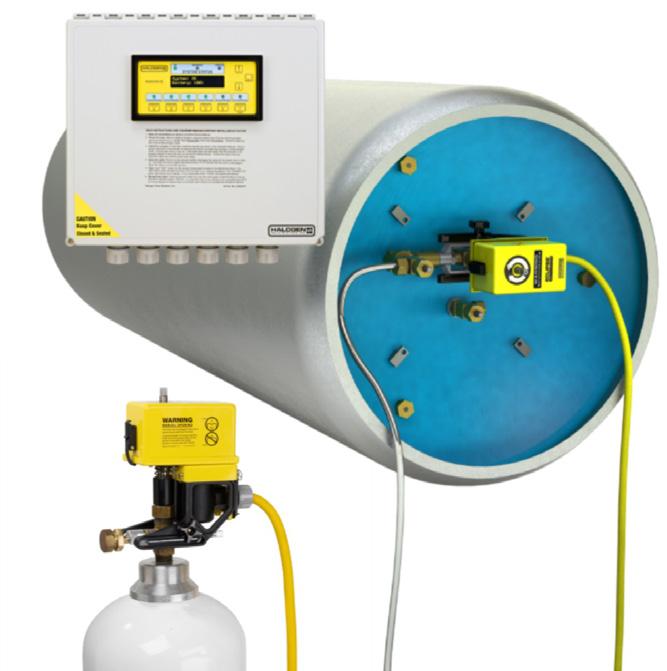
Stop a chlorine leak within seconds of detection by automatically closing the ton container or cylinder valve. The actuator quickly mounts to valve without the use of any tools, and still allows the valve to be manually opened or closed. Halogen Valve Systems are the only systems that confirm that the valve was torqued closed to the institute recommended standard.
Halogen Valve Systems
T: 949-261-5030
W: www.halogenvalve.com

Over the course of its 40-year history, HRS Heat Exchangers has become a global leader in heat exchange technology for the anaerobic digestion and biogas sector, with specific systems to deliver all of these benefits for a range of scales. Today, HRS equipment is installed at hundreds of biogas plants worldwide, helping operators to improve their efficiency and overall operation.
HRS Heat Exchangers
T: 770-726-3540
E: info@us.hrs-he.com
W: www.hrs-heatexchangers.com/us/

The new Stormceptor® EF is an oil grit separator (OGS)/hydrodynamic separator that effectively targets sediment (TSS), free oils, gross pollutants and other pollutants that attach to particles, such as nutrients and metals. The Stormceptor EF has been verified through the ISO 14034 Environmental Management – Environmental Technology Verification (ETV).
Imbrium Systems T: 800-565-4801
E: info@imbriumsystems.com
W: www.imbriumsystems.com

Inspection and maintenance are fundamental to the long-term performance of any stormwater quality treatment device. The Stormceptor EF/EFO design makes inspections and maintenance an easy and inexpensive process conducted at grade. Once serviced, the Stormceptor EF/EFO is functionally restored as designed, with full pollutant capture capacity. Learn more at: www.imbriumsystems.com
Imbrium Systems
T: 800-565-4801
E: info@imbriumsystems.com
W: www.imbriumsystems.com

The IPEX Vortex Flow™ Insert (VFI) revolutionizes vertical sewer drops by eliminating odorous emissions and minimizing corrosion. With no moving parts and zero maintenance, VFIs offer significant cost savings for municipalities across North America.
IPEX
T: 866-473-9462
W: www.ipexna.com
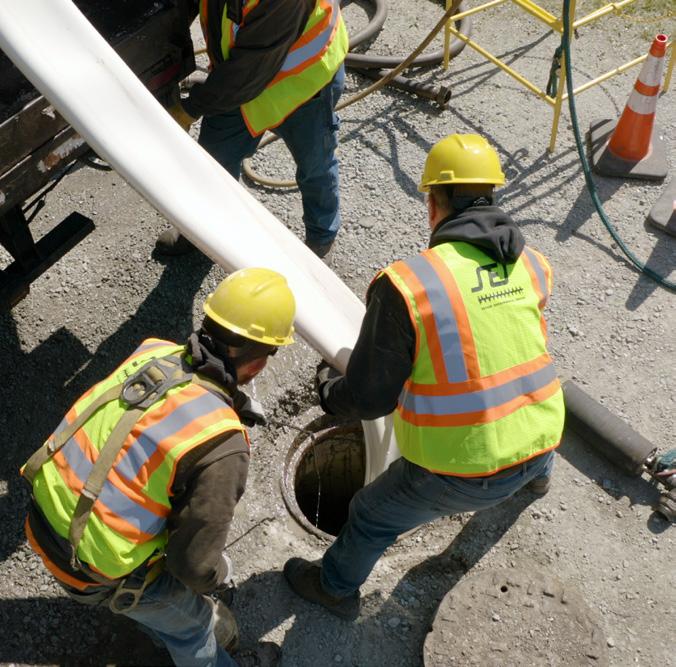
NovaForm™ offers a durable, cost-efficient solution for sewer and culvert rehabilitation. This styrene-free, expandin-place liner eliminates the need to capture and treat contaminated curing liquid. Made from engineered thermoplastic, it is installed using steam, with water as the only job site discharge.
IPEX
T: 866-473-9462
W: www.ipexna.com

OZ Lifting Products has launched North America’s first stainless steel lever hoist that captures the many benefits of Type 304 stainless steel. Available in 0.25-, 0.75-, 1.5-, and 3-ton versions. Each one can be provided with 5 ft., 10 ft., 15 ft., and 20 ft. lengths of lift (custom rigging available). The hoists are lightweight and easy to operate.
OZ Lifting Products
T: 800-749-1064
E: sales@ozliftingproducts.com
W: www.ozliftingproducts.com

HUBER, a proven German manufacturer, now provides watertight doors that allow safe access to tanks for construction and/ or maintenance. Doors can be provided as round or rectangular for installation onto existing concrete surfaces or cast-in-place in new concrete. They can handle heads up to 30 m and hold pressure in seating and unseating directions. HUBER’s watertight doors can greatly reduce construction and maintenance costs and dramatically improve safety/access.
Pro Aqua, Inc.
T: 647-923-8244
E: aron@proaquasales.com
W: www.proaquasales.com

Invent Environment is the manufacturer of hyperboloid mixers which have revolutionized anoxic and swing zone mixing. Invent provides low-shear, efficient mixers with no submerged motors or gear boxes for easy access for maintenance. They have now released the Hyperclassic Mixer Evo 7 which has increased the number of motion fins and adjusted the geometry of the mixer to maximize mixer efficiency, reducing operation costs even further.
Pro Aqua, Inc.
T: 647-923-8244
E: aron@proaquasales.com
W: www.proaquasales.com

Goulds Water Technology’s 5˝ – 11˝ 316SS Submersible Turbine Pumps are engineered for deep-set applications where lineshaft pumps are impractical. Constructed from durable 316 stainless steel, these pumps offer high efficiency and reliability in challenging environments. Ideal for municipal, industrial and agricultural use, they provide a robust solution for demanding pumping needs. Summit Water T: 519-843-4232
E: sales@summitwater.ca
W: www.summitwater.ca

Vanton cantilevered vertical thermoplastic SGK pumps are engineered for the dependable handling of corrosive process fluids, plant effluents and wastewater, over broad pH ranges. Available in polypropylene, PVC, CPVC or PVDF, these rugged pumps are widely used across various manufacturing industries and water treatment facilities. Every Vanton pump is performance tested to the specified service condition intended.
Vanton Pump & Equipment Corporation
T: 908-688-4216
F: 908-686-9314
E: mkt@vanton.com
W: www.vanton.com

Vanton Chem-Gard CGM-ANSI magnetically driven end suction pumps are seal-less, single-stage process pumps which meet ANSI B73.1 specifications and conform to Hydraulic Institute Standards. All wet-end components are homogenous, injection-molded polypropylene (PP) and polyvinylidene fluoride (PVDF), eliminating metal-to-fluid contact, making them ideally suited for handling corrosive, hazardous and ultrapure fluids. Flows to 450 GPM, heads to 180 ft, and temperatures to 225°F.
Vanton Pump & Equipment Corporation
T: 908-688-4216
F: 908-686-9314
E: mkt@vanton.com
W: www.vanton.com
By Bassim E. Abbassi and Tyler Figliuzzi
In the dairy industry, where rigorous hygiene protocols underpin milk quality and food safety, the management of milking centre wash water (MCWW) has emerged as a quiet but pressing concern.
Every milking centre, whether part of a small family farm or a larger operation, relies on water- and chemical-intensive cleaning processes to sanitize pipelines and milking equipment after each session. What’s left behind is MCWW, which is a complex wastewater stream that contains residual milk solids, detergents, acid rinses, and elevated nutrient loads.
While MCWW is a byproduct of responsible sanitation, its disposal poses significant challenges, particularly for farms that rely on on-site septic systems and lack access to wastewater treatment infrastructure. Septic systems are designed to treat domestic sewage, not the concentrated organic and nutrient loads found in MCWW. Yet, provincial regulations governing its management remain inconsistent, leaving many producers navigating a gray zone without clear or practical guidance.
At the University of Guelph’s School of Engineering, our recent research aimed to close this gap. Through fieldwork across 18 dairy farms and in-depth sampling at six representative sites, we identified two straightforward, cost-effective strategies to improve MCWW compatibility with septic systems, and strategies that can empower farms to meet environmental and regulatory expectations without resorting to costly infrastructure upgrades.
Ontario’s regulatory framework for MCWW straddles two key documents: Ontario Regulation 267/03 under the Nutrient Management Act, 2002 (NMA) and the Ontario Building Code , 1992 (OBC).

The NMA permits the use of on-farm septic systems for treating MCWW, provided that the systems meet OBC performance standards by separating the first rinse of the washing process.
However, this permissive stance is complicated by the OBC’s recognition that MCWW is often not equivalent to typical domestic sewage. Elevated concentrations of biochemical oxygen demand (BOD), total suspended solids (TSS), fats, oils and grease (FOG), total nitrogen (TN), and total phosphorus (TP) make this waste stream significantly more challenging to treat biologically.
This regulatory mismatch creates confusion, particularly for small and midsized farms seeking to remain compliant, while maintaining cost-effective waste management practices. Without targeted technical guidance or explicit thresholds for MCWW, producers are left to interpret whether their existing systems are suitable, or require modification. In practice, many septic systems risk overload, premature failure, or envi-
ronmental discharge violations due to the unmitigated strength of this effluent.
The implications of poorly managed MCWW are multifaceted. From an environmental perspective, nutrient-rich discharges can contribute to eutrophication in surface waters, promoting algal blooms and reducing oxygen availability for aquatic life. On the farm, a compromised septic system can result in frequent maintenance issues, backups, and costly repairs, with potential regulatory penalties if untreated effluent reaches the environment.
Economically, the stakes are high. Ontario’s dairy industry generates more than $2.3 billion annually in farm cash receipts. For producers operating on tight margins, especially in rural regions, unplanned system upgrades or fines can have outsized financial impacts.
To understand how MCWW challenges conventional septic systems, it’s essential to examine its origin. The cleaning cycle in a typical milking operation involves four main stages:
• Pre-rinsing flushes out residual milk from the system.
• Detergent washing uses alkaline cleaners to remove fats and proteins.
• Acid rinsing prevents scale buildup and sanitizes pipelines.
• Sanitizer rinsing ensures microbiological safety prior to the next milking.
Each of these stages contributes specific contaminants. Pre-rinse carries milk solids rich in organic matter, elevating the BOD and TSS. The acid rinse, depending on its formulation, may introduce significant loads of nitrogen and phosphorus compounds.
Our field data revealed wide variations in contaminant profiles between farms, depending on product selection, cleaning frequency, water use efficiency, and system design. This variability underscores the need for targeted interventions tailored to actual wastewater characteristics, rather than assuming uniformity across farms.
Our study identified two critical, actionable changes that can significantly reduce the contaminant load of MCWW, making it more amenable to treatment in standard septic systems.
One of the most influential variables affecting MCWW quality is the choice of acid rinse product. Farms using cleaners formulated with phosphoric acid or nitric acid consistently exhibited high concentrations of TP and TN in their effluent. In some instances, TN exceeded 100 mg/L, and reactive phosphorus levels approached 390 mg/L, values well beyond the treatment capacity of typical septic systems.
By contrast, farms that used sulfuric acid-based cleaners, without added phosphorus or nitrogen, showed significantly lower nutrient concentrations. Switching to low-nutrient or nutrient-free acid rinses is an effective and low-cost continued overleaf…



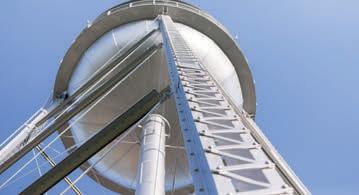
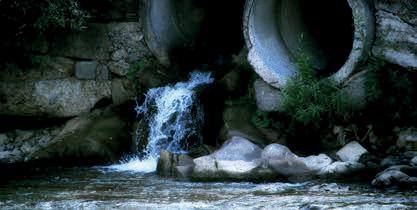













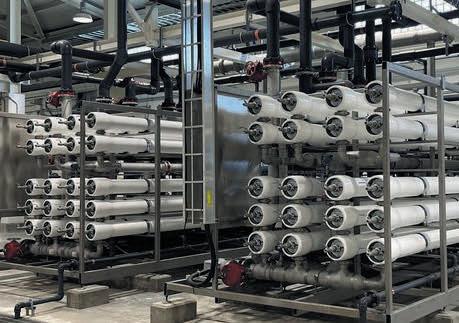



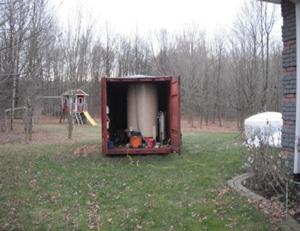
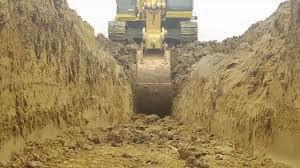



Register your company at esemag.com/get-listed
method to reduce septic system loading.
A less commonly adopted but equally impactful practice is the use of a compressed air rinse prior to the pre-rinse stage. This step pushes residual milk from the pipeline back into the bulk tank, before any water is introduced. This keeps high-strength organic material out of the wastewater entirely.
The results are substantial. In one comparison between two farms milking Guernsey cows (noted for high butterfat content), the farm using an air rinse reported a 61% reduction in BOD and a 76% decrease in TSS relative to the farm that did not. These reductions also led to a notable decrease in FOG.
On average, farms using air rinses consistently approached or met the OBC’s benchmark of 300 mg/L BOD, an important threshold for septic viability. For farmers looking to treat their MCWW using an on-site septic system, adopting an air rinse can also eliminate the need to separate the first rinse. This intervention requires modest investment in hardware but delivers outsized returns in terms of effluent quality and system performance.
Based on our findings, dairy producers who wish to continue using septic systems for MCWW should consider implementing the following best practices.
• Avoid acid cleaners containing phosphoric or nitric acid. Transition to sulfuric acid-based formulations with low or no nutrient content to minimize TN and TP in effluent.
• Install a compressed air rinse step. This upstream intervention significantly reduces the organic load, helping farms stay within septic system treatment thresholds.
These changes are both technically feasible and economically accessible, requiring minimal disruption to existing operations.
Beyond on-farm practices, our research underscores the need for coherence between regulatory frameworks. As it stands, the permissive language of the
Our study identified two critical, actionable changes that can significantly reduce the contaminant load of MCWW.
NMA does not align with the performance-based constraints of the OBC. This disconnect places the onus on farmers to interpret and reconcile regulatory ambiguity, often without adequate support or technical guidance.
Policymakers should consider updating both documents to reflect current scientific understanding of MCWW characteristics and treatment potential. This might include developing clear effluent thresholds, promoting proven best practices, and supporting producer education.
Milking centre wash water is an unavoidable byproduct of modern dairy production. But, with informed practices and regulatory clarity, it need not be a liability. By adopting simple but effective strategies, such as switching acid products and adding an air rinse, farms can significantly improve wastewater compatibility with septic systems.
At the same time, aligning policy with science will be key to ensuring that Ontario’s dairy sector remains both productive and environmentally responsible. Our research provides a practical starting point, one that we hope contributes to more sustainable and streamlined wastewater management for the future of farming in the province.
Bassim E. Abbassi is Director of the Ontario Rural Wastewater Centre, School of Engineering at the University of Guelph. Tyler Figliuzzi is a MASc graduate of the School of Engineering at the University of Guelph, Email: babbassi@uoguelph.ca, tfigliuz@uoguelph.ca
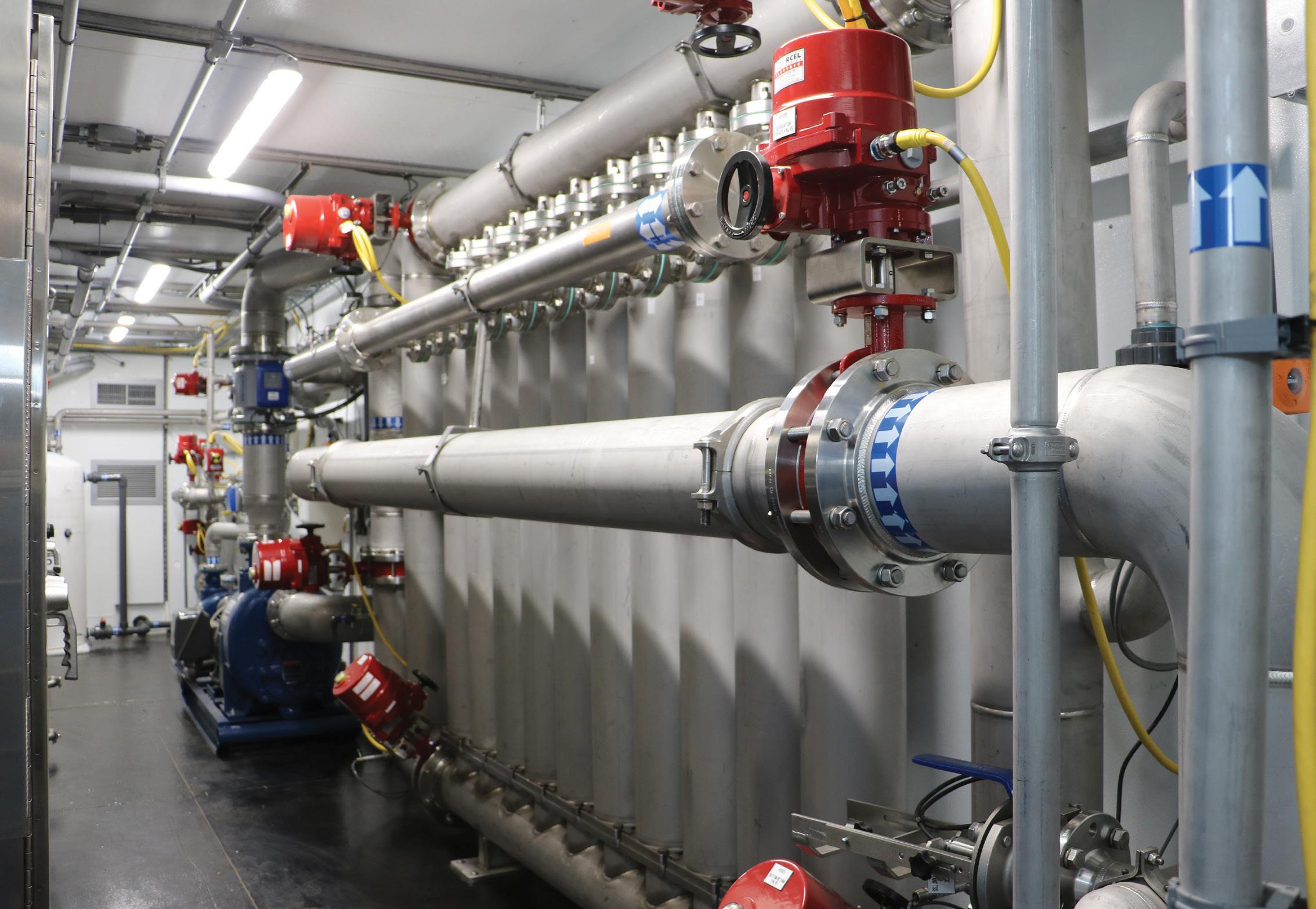









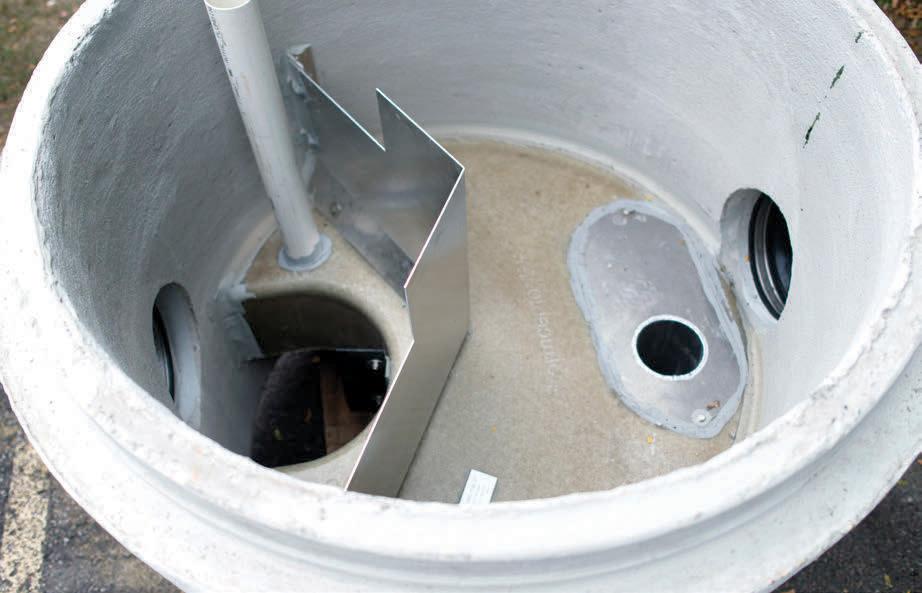
The most complete oil-grit separator on the market
• High flow sediment removal
• Scour prevention of collected sediment during high flow
• 99% oil/hydrocarbon retention during high flow
• Canada ISO 14034 Environmental Technology Verification (ETV)
PRODUCT RECOMMENDATIONS
SIZING & DESIGN ASSISTANCE
Imbrium® has been synonymous with stormwater treatment in Canada for decades. With the Stormceptor® EF oil-grit separator and the Jellyfish® Filter membrane filtration system, Imbrium® provides engineers and regulators options for all levels of stormwater treatment.

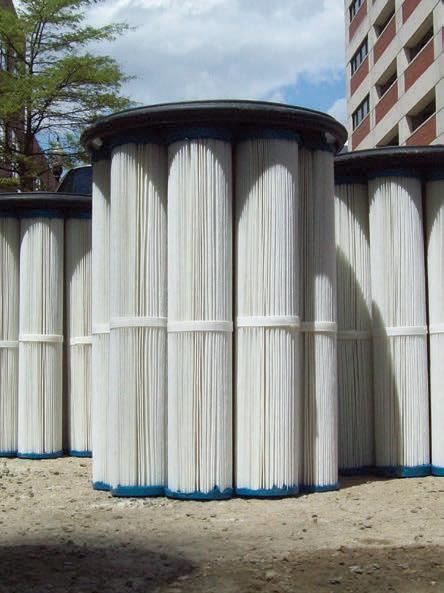
The highest level of sediment and nutrient removal using membrane filtration
• Removal of 90% TSS and 77% TP
• Low driving head of 457mm
• Lightweight, rinseable and reusable cartridges
• Canada ISO 14034 Environmental Technology Verification (ETV)





